
Cuba in July: Why It Can Be the Best Time to Visit Cuba
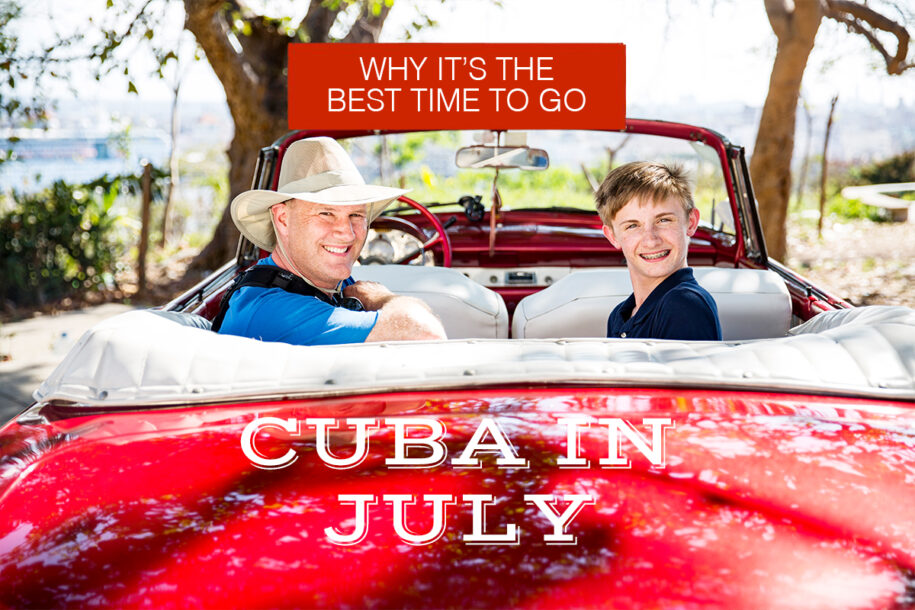
There’s something magical about the month of July in Cuba. If you live in the northern hemisphere then this is also when your mind probably wanders to thoughts of where to go for your summer vacation.
Cuba is a remarkable place to visit at any time of the year but there is something undeniably special about Cuba in July. The weather is warm though occasionally turbulent, and despite it being the height of the busy summer period in many parts of the world, the island is arguably at its best in July.
So what is it about this dreamy, balmy month of July that makes it an ideal time to visit Cuba?
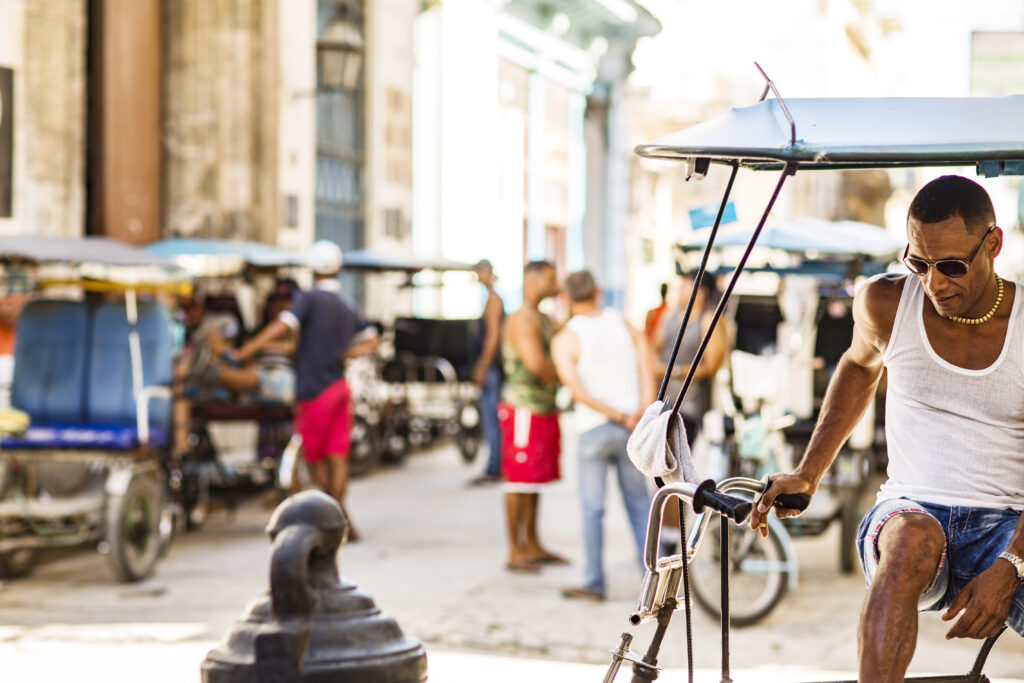
The Weather in July
Cuba in July is about the best you can ask for in terms of enjoying the warmth of the tropics. There is sunshine, heat and a moderate amount of humidity, although this is often broken by a brief shower in the evening to cool everyone off.
This time of year is also classified as hurricane season for the entire region, although this is not something to really be concerned about. Hurricanes do affect Cuba from time to time, but by and large they can just briefly influence the weather as opposed to actually striking the island.
Cuba in July is actually in the midst of the wet season, but again this is not anything to be concerned about. In the tropics you can sometimes expect a brief, intensive shower in the evening which can actually be rather darn refreshing as it breaks the heat, giving you a respite if in fact Cuba in July is too warm for you.
But this means that it can be wise to pack a lightweight waterproof poncho in your suitcase and to carry it with you. The rainy season also means that it’s mosquito breeding season (the little devils reproduce in the puddles left behind after a shower) so please remember to bring some insect repellent. It’s more of an issue in rural areas and yet it’s better to be safe than sorry. And there is also the fact that insect repellant can be difficult to track down in Cuba itself.
How Warm Will it Be?
There will of course be variations in temperature across the island, depending on where you will go. The inland areas will not receive much in the way of cooling ocean breezes, for example. As a rough idea, the temperature in Havana in July will range from a high of approximately 31°C (88°F) down to an overnight low of around 23°C (74°F) with an average daily temperature of approximately 27°C (81°F).
So it’s going to be undeniably warm, and you couldn’t ask for better beach weather. But it’s without the oppressive heat and humidity that can be a trademark of August days in Cuba. One July in Havana it got as warm as 37°C (98°F) but such a hot day is a rarity. And as mentioned, there will be some changes to what can be expected in terms of temperature depending on where you go. So it’s best to not stray too far from places that serve a cold drink.
Cuba in July is perfect beach weather, and it’s a fantastic idea to spend a few days lazing around on the sand. Just remember that the beaches closest to urban centers can become quite crowded (and the same goes for the sands next to the beach side resorts) so arrive early in the day to claim your spot on the sand, or venture to one of the further out beaches if you don’t want the area to be too crowded.
So for example, if you were in Havana and wanted a somewhat more peaceful beach experience, you would go to Playa Boca Ciega instead of Santa María del Mar.
The Importance of Booking Ahead
July is one of the busier months on the Cuban calendar. There’s some logic to this. It’s summer in the northern hemisphere, and so a lot of people want to take a summer holiday. The kids are out of school and everyone wants to sit on a beach with a cold drink in their hand. This means you can’t take it for granted that your preferences in terms of flight dates and accommodation will readily be available when going to Cuba in July. You really should book ahead as much as is possible. While internet is slowly becoming more widespread on the island, some businesses might not be as contactable as you are used to (some places might not check their emails each and every day, for example – especially if they need to go to an internet kiosk or dedicated wifi zone in order to do so).
So please allow yourself plenty of time to make enquiries about where you want to stay and what you want to do, and book with as much time to spare as possible.
What to Do in Cuba in July
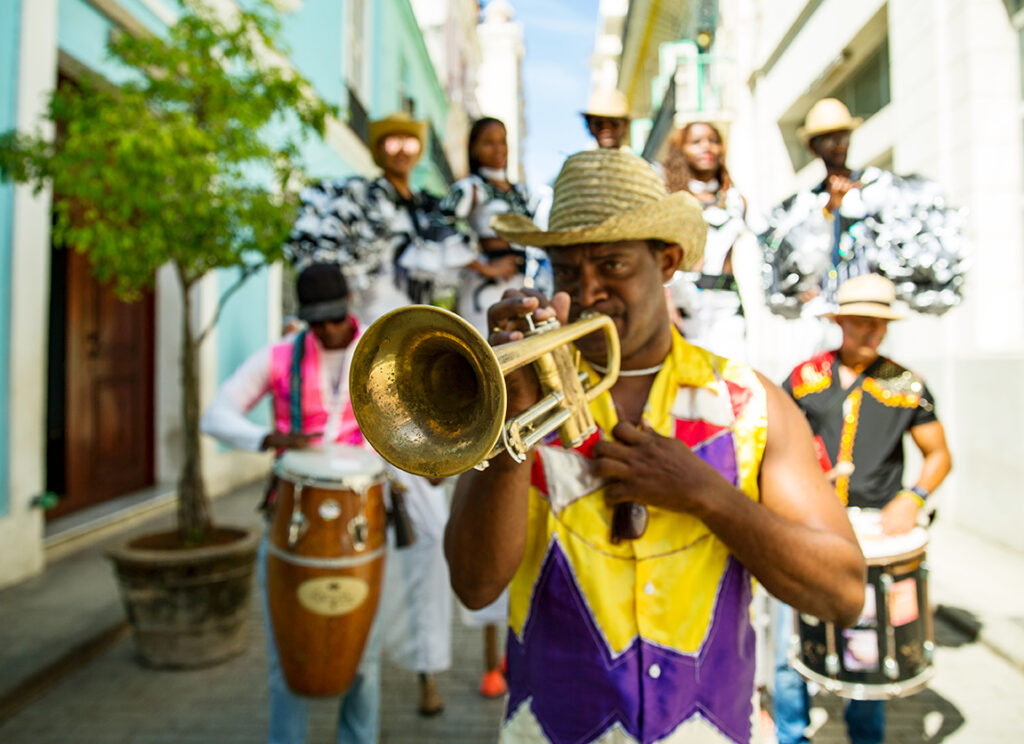
Let’s be honest here… this is Cuba so it’s not as though you will ever be lacking something to do. If you happen to visit Cuba in July there are a few special celebrations that you will want to be a part of. July 26th is Revolution Day in Cuba. On this day in 1953 Fidel and Raul Castro led an attack on the Moncada military base, which essentially kicked the Cuban Revolution into gear. Regardless of what you might think about Cuban politics, it’s a special day for Cubans with celebrations and commemorations across the country. On a more festive note, July is also carnival month. Arguably the best of the lot takes place in Santiago de Cuba (the actual dates vary, but it’s in the second half of July).
The whole town feels like one big street party, with dancing in the street and parades everywhere. You will need to have a relaxing few days of recovery after carnival season in Cuba.
BUILD YOUR OWN TAILOR-MADE CUBA TOUR ITINERARY WITH US!
- Search Search Search …
- Search Search …
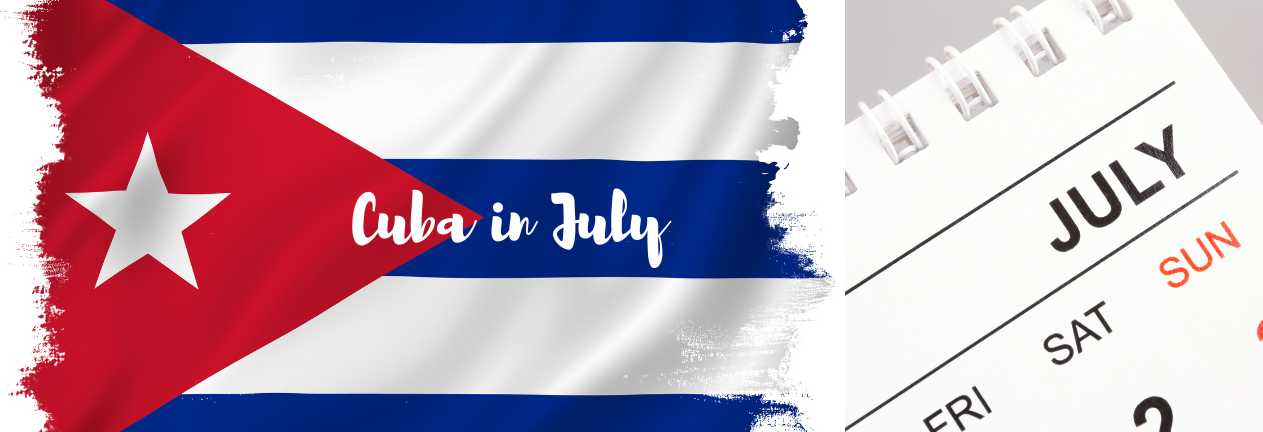
Visiting Cuba in July: Events, Activities, and Weather
July is one of the liveliest months of the year to visit Cuba. Schools have their main summer holidays during this month and there are revolutionary celebrations too. You’ll find fewer international visitors, but more domestic tourists and visitors. Head to the revolutionary cities of Santiago de Cuba, Santa Clara, and Havana if you want to take part in the Revolution Day celebrations, or the beach if you want to chill out. Here’s what there is to do in Cuba in July.
THIS POST MAY CONTAIN COMPENSATED AND AFFILIATE LINKS. MORE INFORMATION IN OUR DISCLAIMER
Whether you’re visiting Cuba for the cultural aspects, the beach life, or a combination of both July is an interesting time to visit. You’ll meet quite a few domestic tourists at this time, heading to the beaches – check out our guide to Cuba’s best beaches here – and also aiming for the festivals and celebrations happening in Cuba during July.
The Weather in July in Cuba
The weather in Cuba in July, is warm. While this is classed as hurricane season, the risks are generally low for this month in Cuba. While July in Cuba is part of the wet season rain does tend to be, as I mentioned, brief. However, this is also mosquito breeding season, so come prepared with bug spray, and long light clothes. While it is official hurricane season in Cuba in July you’re unlikely to see one.
TOP PRODUCT PICK

Best Bug Spray For Cuba
Effective bug spray deters mosquitoes, gnats, and ticks. This pump spray is good for protecting you against bugs and contains 40% DEET.
Temperatures in Cuba in July
You’ll usually find temperatures from 23 to 31 Celsius (73 – 88 Fahrenheit) and while there may be some rain it tends to be brief, although it is likely to be moderately humid. Overnight lows will be around 23-25 Celsius (73 – 77 Fahrenheit), which can be very warm for some.
Rainfall in Cuba in July
There is average rainfall in July in Cuba of 76 mm (3 inches), but it tends to be loaded towards the beginning of the month. And rain showers tend to be heavy, but brief, rather than persistent. Rainstorms tend to occur in the late afternoon.
Things to do in Cuba in July
July is revolution month in Cuba. 26 th July is Revolution Day – it was on this day in 1953 that Fidel and Raoul Castro attacked the Moncada base in Santiago de Cuba and the (most recent) Cuban Revolution came to pass. July in Cuba is also Carnaval month and many events in the country are focused on this. This is summer in Cuba and Cuba’s school summer holidays cover July and August, nicely coinciding with these festivities.
Top Tours and Activities to book During July
You’ll want to take a revolution-focused tour if you’re visiting Santiago de Cuba. And, of course, make sure you take a Cuban Classic Car tour. Book all your transport and accommodation ahead of time.
What is there to see in Cuba in July?
Head to a beach in Cuba during July – Varadero is the country’s number one beach resort and there’s lots to do there, (I mean besides lying on the beach), and some great places to explore nearby Varadero too.
Head down the island to Santa Clara – and pay your respects to Che Guevara while seeing the site of the Tren Blindado
Make a beeline for Santiago de Cuba – the center of the revolutionary celebrations and don’t miss seeing the Cementerio de Santa Ifigenia, the final resting place of Cuba’s revolutionary heroes.
What is there to do in Cuba in July?
Tours and attractions tend to be open year-round in Cuba (although they will be closed on Revolution Day, 26 th July), so you can continue to book and expect to be able to go to most of the iconic things that you’ve come to Cuba to see.
Check out the UNESCO World Heritage Vinales Valley – either visit for several days, or take a day trip from Havana
Explore UNESCO World Heritage Trinidad and the stunning Topes de Collantes National Park nearby.
It’s perfect diving weather, so head to the Bay of Pigs and go diving .
There’s more inspiration on what to do in Cuba in our guide to the top iconic things to do in Cuba here.
Events in Cuba in July
There are several events of note in Cuba in July – and if you’re planning on visiting Cuba in July, then you’ll need to plan with booking your casa particular or hotel (its school holidays so its busy), and also any transport you need – like the Viazul Bus or a transfer. Dates differ each year for all of these events (apart from Revolution Day, which is always the 26 th of July). These are the events in July in Cuba
The Festival del Fuego in Santiago de Cuba is a week-long celebration of Caribbean dance and music. There are carnival troupes, concerts, and lots going on. This happens in early July in Santiago de Cuba and dates vary slightly each year. The Festival del Fuego (Festival of Fire) is also known as the Festival del Caribe (Festival of the Caribbean) and is free. The Festival del Fuego has been running since 1981 and brings in thousands of international performers and visitors, who focus on the themes of the culture, religion, and history of the Caribbean region. The festival culminates with a Fire Parade on the last night, with a burning of a huge effigy of the Devil, while a cavalcade of drums sees the festival off.
Cuba’s largest and most traditional carnival is held in Santiago de Cuba every July – running up to and encompassing the July 26 th Revolutionary celebrations. In 2023 it’s scheduled to run from July 25th to July 27th. You’ll find the main parade on either Alameida or Garzon. This Carnival in Cuba’s second city – and it has to be said, the most exotic city comes about because of the huge mix of cultures from those who have settled here over the centuries. What makes the Carnaval of Santiago even more special is the rich mix of music and dance that you’ll find here, in this, Cuba’s hottest city.
Revolution Day – aka the day of National Rebellion aka the July 26 th Celebrations aka el Dia de la Rebeldia Nacional is the most important day of the year in Cuba. There are celebrations across Cuba, but the biggest and most important are those at the Moncada barracks in Santiago de Cuba. There are political speeches, street parties, and concerts throughout. The best cities to visit during this celebration are Santiago de Cuba, Havana , and Santa Clara.
Why visit Cuba in July?
If you’re looking for the best time to visit Cuba, then July might not be a bad option. There are celebrations galore, and if you’re a history buff interested in the Cuban Revolution, then you’ll get to experience the National Day of Celebration firsthand. Consider taking our 7 day Cuban Revolution itinerary as a starting point for where to go.
For the wet season, this is a good option, as the rain starts to taper off towards the end of the month. The flight will likely be cheaper, but also there aren’t so many of them, so you’re competing for space on buses and in casa particulars with domestic tourists.

Best Travel Mosquito Net for Cuba
This travel mosquito net fits over a king-sized bed and comes with a bag, and hanging hooks for easy setup. It’s easy to use and good for a great night’s sleep.
While the weather is temperate the water temperatures are perfect for swimming in the sea and if you’re a sports fisherman, then this is marlin season too. You’ll find boats heading out from Havana and Varadero in the main to catch the Gulf Stream off the coast of the north of Cuba.
Is it busy in Cuba in July?
Yes and no. This is the school holiday season and it’s also carnival and Revolution Day, however, the tourists are mainly domestic tourists. This is not a high season for international tourists. As several festivals are going on, and especially if you plan to travel around Revolution Day you’ll want to make sure you book your transport and accommodation well ahead of time.
What it’s like in Cuba month by month
Here are our guides on what you can expect when visiting Cuba in different months.
- Things to do in Cuba in March
- Cuba in April
- Cuba in July – events, activities, and weather
- Cuba in August – events, activities, and weather
- Cuba in September – what to expect
Final Words on Visiting Cuba in July
July is usually the offseason for international visitors in Cuba, but you’ll find more domestic tourists, as it’s school holidays and festival time in Cuba. The beaches will be busy, and transport will be too, so book ahead. Celebrate the revolution, head to a beach, or do a little of both. You’ll definitely get a different flavor of Cuba by coming here during July.
Cuba’s Best is a participant in the Amazon Services LLC Associates Program, an affiliate advertising program designed to provide a means for sites to earn advertising fees by advertising and linking to amazon.com, amazon.co.uk, amazon.ca. Amazon and the Amazon logo are trademarks of Amazon.com, Inc. or its affiliates .
Sarah Carter
Leave a comment cancel reply.
Your email address will not be published. Required fields are marked *
Save my name, email, and website in this browser for the next time I comment.
Privacy Overview

Cuba in July
Home > Blog > Cuba in July
Beaches, music, history and scenery; there isn’t much that you can name that Cuba doesn’t have on offer. This small island off the coast of South America is loud, lively and full of unexpected sights and activities to discover, making it one of the most popular locations for a holiday in recent years.
Visiting Cuba in July will expose you to some of the stormy weather belonging to the country’s wet season, but this should not deter your decision to stay. July is one of the most interesting months in Cuba’s cultural calendar, and travelling outside of the tourist season will provide you with a much more authentic experience of the island.
Jump to…
Reasons to visit Cuba in July

- The country’s biggest and most famous carnival takes place in July in Santiago de Cuba, and is an unmissable cultural event
- July sees less rain than the surrounding months of the wet season, so your trip won’t be interrupted by storms the entire time
- Whilst beach resorts and coastal areas are likely to be very full in July, popular places like Havana and Trinidad will have emptied of tourists and are much less busy than usual
Weather in Cuba in July

July is one of the hottest and most humid months of the year in Cuba, but despite being part of the country’s wet season there doesn’t tend to be that much rain. Weather in July in Cuba will likely be best in the mornings, with rain and tropical storms more likely to strike in the afternoons and then clear by the evenings.
Chances of a hurricane whilst visiting Cuba in July are minimal, but there is a higher risk than if you were visiting during the island’s dry season. And whilst most heavy rain showers pass quickly, you may encounter a few longer-lasting tropical storms during your stay.
Temperature
Temperatures in Cuba in July are high, with top average temperatures reaching 32°C in the middle of the afternoon. The lowest average temperature in July is 23°C, so it is worth ensuring that your accommodation has air conditioning as this will make it a lot easier to get to sleep at night despite the heat.
July is also an incredibly humid month in Cuba, and heat is likely to feel even more oppressive because of this. Make sure that you bring a lot of light clothing, and stay indoors during the hottest parts of the day to keep cool.
Sea Temperature
The temperature of the sea in Cuba in July is a very high 29 °C which is ideal for swimming when the weather is good. Taking a dip in the ocean is one of the best ways to cool off during the humid July heat, but make sure that you are never in the water during a storm.
Clouds and Rainfall
July experiences less rain than other months in Cuba’s wet season, with 12 days of rainfall on average and the middle of the month tending to be the driest point. Any rain that does appear will tend to fall in the afternoon, and most showers will be heavy but won’t last for very long.
Unlike the previous month, cloud coverage in July decreases as the month progresses, and you will likely see more sunshine during the day as August approaches.
Sunshine Hours
There are nine hours of sunshine every day on average in Cuba in July, with the sun tending to rise just before 7 am and setting around 8.15 pm every evening. When out in the sunshine you will be exposed to strong UV rays, so make sure that you regularly apply sun cream whilst outside to stay protected.
Where to go in Cuba in July

Santiago de Cuba
July is one of the best times to visit Santiago de Cuba because of the events that take place in the city during the month, but there is more to the location than just festivals and carnivals. Santiago is known as the most diverse city on the island because of its strong Caribbean roots, and if you can handle the heat and humidity that July brings to the city then you won’t be disappointed with what else you discover.
Famous for its colonial history and musical heritage, Santiago is an excellent place to visit if you want to experience both the Caribbean laid-back atmosphere and the energetic Cuban spirit. As well as relaxing on the beaches when the weather is good or sipping rum cocktails in the evenings, you can also appreciate the city’s history at the Museo Emilio Bacardí Moreau or admire the impressive El Castillo del Morro San Pedro de la Roca fortress that was built to protect the area from pirates.
Mar í a la Gorda
If you are desperate for a beach holiday in Cuba in July but don’t want to spend your time in a packed beach resort, then the small settlement of Mar í a la Gorda is an ideal destination. Situated on the west of the island, the area is mainly frequented by those who are serious about diving , and only has a small shop, diving centre, a hotel and two restaurants.
The beaches at Mar í a la Gorda are perfect and unspoiled, and on dry and sunny days they offer the perfect solitary spot for rest and relaxation.
Whilst other travellers are flocking to the coast, those who want to spend their time exploring Cuba’s more urban areas should visit Trinidad. This large town is in central Cuba and doesn’t see too many tourists over the summer season, meaning you can enjoy escaping the heat in the town’s museums or admiring the colourful buildings lining the streets in peace.
The centre of Trinidad is a UNESCO World Heritage site with famously cobbled streets and does not allow any traffic. You can sit in the beautiful Plaza Mayor or visit all of its surrounding museums on a cloudy afternoon, or head north to the Loma de la Vigía hill that overlooks Trinidad for some excellent views of the area.
Things to do in Cuba in July

Take a Road Trip
A great way to explore a lot of Cuba over your holiday in July is taking a road trip around a number of popular locations , either in a modern car or one of the classic, vintage vehicles that the country is famous for. You can do a circle of the whole island if you are staying for a long time, or just cruise along the coast between Havana and Varadero or Trinidad and Cienfuegos for a day.
Try Salsa Dancing Classes
If you are out and about in the evenings in Cuba then you will likely come across a bar or restaurant with live music, which often leads to an impromptu salsa dancing session from the locals. Whether you want to be prepared for the music at Santiago’s carnival, or just want to know what you are doing in a nightclub, many cities like Havana offer salsa dancing lessons for tourists to get you up to speed on how to move to the infectious beat of Cuban music.
Explore the Museum of the Revolution
With July hosting the most important date in the history of the Cuban Revolution, a trip to the museum dedicated to the country’s political history is an appropriate activity for an afternoon where the rain sends you seeking cover. The museum is in the impressive neo-classical Presidential Palace in Havana and features artefacts, images and stories that detail the country’s communist rebuilding.
Visit the Hotel Nacional de Cuba
Another great place to pass the time when the weather is bad in Cuba is the Hotel Nacional in Havana, which is possibly the country’s famous hotel. Whilst rates to stay overnight are very high, you can still visit the bar or restaurant if you are not a guest and marvel at the famous figures who have graced the rooms you are now sitting in.
Crowds & costs

Although the weather in Cuba tends to be incredibly humid throughout the month, July is one of the busiest times of year on the island, as many Cuban residents take their holidays and enjoy discount prices for locals at beach resorts across the country. Prices for foreign visitors will be high in coastal areas and are best booked well in advance to secure the best deals.
Cities and regions that do not have a lot of beach resorts will be quieter for those visiting Cuba in July, as the majority of crowds congregate in places like Varadero or Caya Coco. Whilst hotel, flight and car rental prices may rise a little during the month they are still significantly lower than during peak tourist season.
July festivals & events

Festival del Fuego
In the first weeks of July every year, the city of Santiago de Cuba hosts the Festival del Fuego, also known as the Festival del Caribe. The festival is held to celebrate Caribbean culture, people and history with parades, performances, workshops, talks and numerous street parties.
The festival’s main event is the fire parade on the final evening, which begins with a ritual salute to a god from the Palo Monte religion, Nzambi Congo. The parade then finishes with the burning of a giant devil statue and huge drum performance, followed by celebrations that usually last until the morning.
Santiago de Cuba Carnival
The most famous event that takes place in Santiago de Cuba in July, and perhaps the most famous event in all of Cuba, is the traditional carnival that brings together music, dance, colour and the infectious party spirit of the city. As the most diverse Cuban city, Santiago de Cuba is the perfect place to celebrate the mix of cultures and traditions that create the famous carnival celebration, which is one of the most popular events all year round.
A famous element of the carnival are the congas, which are very different from the western version of the dance that involves following a line of people around a room. Santiago de Cuba’s congas are groups of local musicians that travel through the streets during a carnival, playing driving rhythms and collecting dancers as they pass, and are a unique phenomenon that ought to be witnessed, and joined if you are feeling brave!
Dia de la Rebeld ía Nacional
The 26th of July in Cuba is a significant date in its revolution history, known as the Day of National Rebellion. Celebrating the date in which Santiago de Cuba’s Moncada Barracks was attacked, and when the Cuban revolution was said to have officially begun, this day in July is celebrated in every city across the country.
Cuban residents take to the streets to celebrate the country and its communist triumph, with televised speeches from political figures and, this being Cuba, street parties, live music and outdoor performances.
Frequently asked questions about Cuba in July
What is the rainy season in Cuba?
Cuba has two distinct seasons; wet and dry, and the rainy season takes place from May to October. Temperatures during this time tend to be high and the weather is wet and humid, with high chances of heavy rainfall every day a very small risk of hurricanes.
Is Cuba too hot in July?
July is one of the hottest and most humid months in Cuba with an average high of 32°C during the day , and those who are not used to very high temperatures might find the climate uncomfortable. However, many places have air conditioning to help with the heat, and you can stay cool by keeping indoors or swimming in the sea.
How expensive is Cuba?
Cuba is considered a location that is still relatively untouched by tourism, and visiting the country in July will provide you with a real look at everyday life on the island, as well as traditional festivals and events that celebrate Cuba’s unique culture and history. Visiting Cuba in July means that your holiday takes place before the tropical storms really settle in, and you should be able to enjoy a good amount of sunshine as you explore and enjoy both rural and urban areas.
Related posts

Cuba in April

Cuba in December

Cuba in November
Some of the links on this page are affiliate links, which means we can earn a small commission when our visitors click on them. This helps us to keep our content free and accessible for everyone, but you’ll never be charged for engaging with them.

About Contact Blog

© 2020-2024 The Travel Aisle

Choose your language
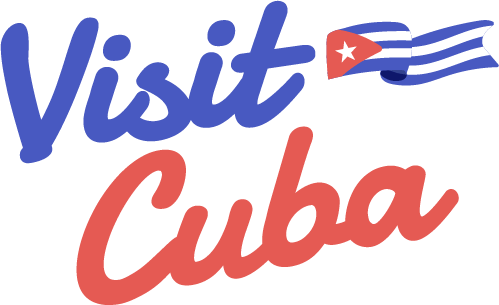
Cuba up close
When Is the Best Time to Visit Cuba?
Beach resort in Varadero
Photo: Shutterstock
In the heart of the Caribbean, close to the equator, Cuba is warm all year round.
Are you planning a trip to Cuba for the coming year? From its tropical beaches to internationally-renowned classical ballet performances, this curvy tropical island has fun activities for every taste. But as you try to narrow down your itinerary while in Cuba, you may wonder what the best time to visit Cuba is.
Will the weather allow you to do everything you want? Is there a festival that would put your experience on steroids? Read more here!
Cuba Climate: What To Expect Around the Year
The first thing that will change depending on the month of your visit is the weather. Like the rest of the Caribbean, Cuba is a land of “endless summer” – at least at first glance. While you can definitely find outdoor activities around the year, some months will have cooler climates, sunnier skies, or even lower prices.
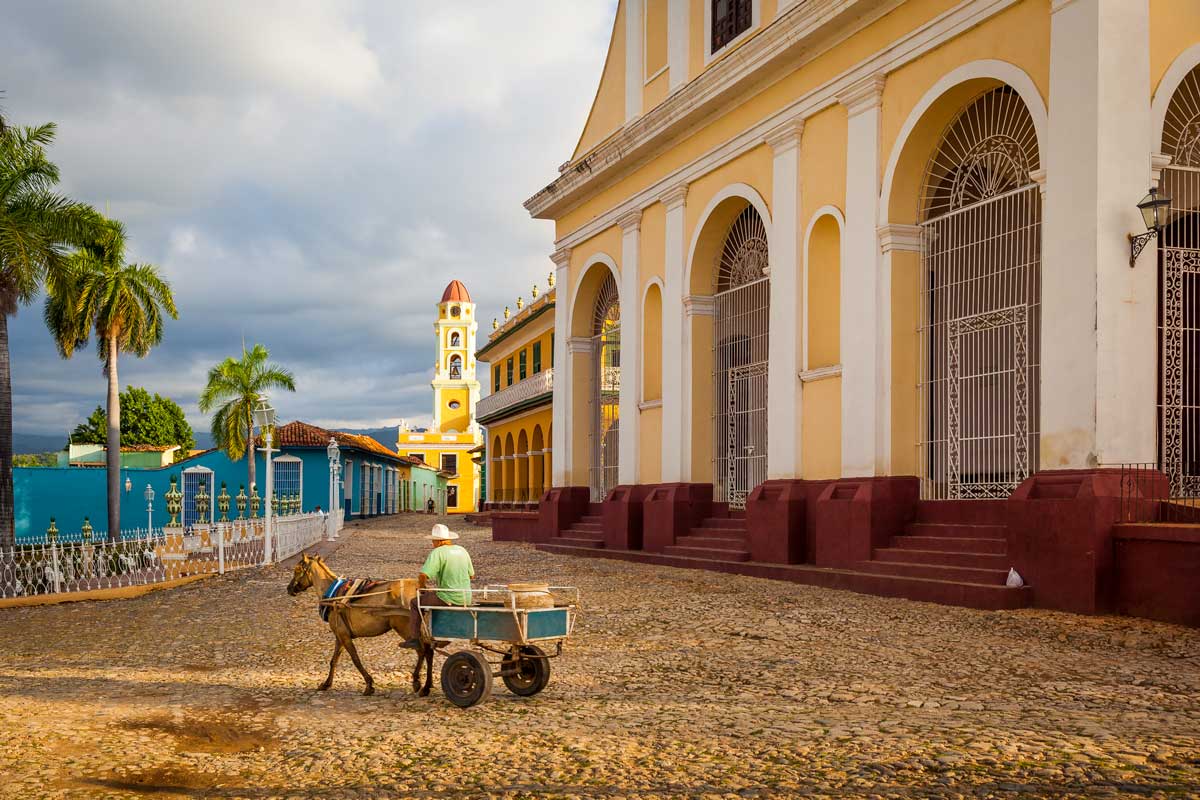
Church of the Holy Trinity overlooking Plaza Mayor, Trinidad
Seasons in Cuba
Cuba doesn’t have the traditional four seasons that temperate regions do. Instead, it has just two: a “dry” season and a “rainy” one.
The dry season lasts from November to April, and it is characterized by less frequent rain, although it’s far from completely dry. During December and January, average temperatures also dip slightly (but never reach “cold” levels under any definition), and the air gets a bit drier, which helps the air feel cooler overall.
The rainy season lasts from May to October. Expect short showers nearly every day and full-blown rainy days at least once a week during this season.
As local legend would have it, the first rains of May are particularly auspicious, as they can relieve chronic diseases and cleanse your spirit from impurities.
Hurricanes in Cuba
So what about hurricane season? Technically, hurricane season overlaps with the end of the rainy season, between June and November. During this time, the sky can go from bright to gray in a matter of minutes.
As for actual hurricanes – they rarely hit the island, and they are unlikely to affect your safety or your belongings. Cuban citizens like to joke that nothing works as well in Cuba as the Civil Defense office. You may need to spend a day safe indoors, but on the other hand, you will be able to experience one of the quintessential “island experiences.”
High versus low season
Let’s talk about tourism seasons, as they will affect the ease with which you book and the final cost of your trip.
There are two peak tourism seasons in Cuba. The first one goes from late December until March (or from Christmas to the Easter break). This is also the sunniest and coolest time of the year when the beaches are at their most enticing (and if you come from the Northern Hemisphere, that’s exactly what you’ll be needing).
The second “peak” covers most of July and August. During this time, Cuban schools will be on recess, so expect longer lines at many nature parks and museums, and you may need to share the beach with other humans.
The low season goes from early May to late June (prices drop as temperatures rise) and between September and October (tourism slows down at the start of hurricane season). During this time, expect lower prices, quieter beaches, and the opportunity to stroll around museums at your own pace.
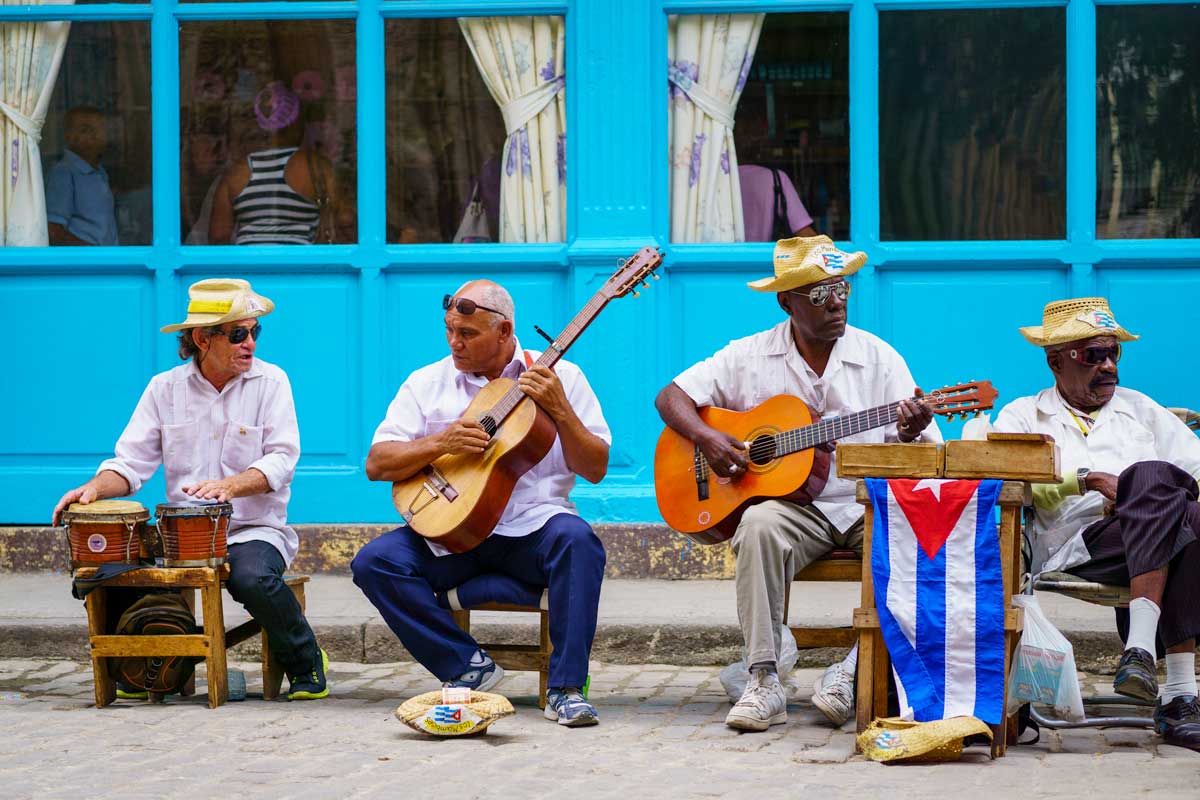
Street musicians in Havana
Dealing With the Tropical Heat
If you live in a cooler or temperate country, you may be worried about handling Cuba’s tropical heat. The sharp temperature change can be a bit disconcerting, especially if you travel during your winter. Don’t worry! In my twenty-something years of living on this island, I’ve gathered a few pro tips that will help you handle the heat waves as the locals do:
- - Make sure you wear sunscreen of at least SPF 50. Even if you don’t “burn and peel” easily, a mild sunburn will leave you with a permanent cloud of heat around your body the next day.
- - Wear loose, thin clothes with long sleeves in cotton or linen. Try to keep the handcuffs and waistlines loose to allow air to flow around you.
- - Remember, “siesta” was invented for a reason! Just because we all seem to disappear right after lunch doesn’t mean we are truly sleeping. Between noon and 3 PM, it’s best to plan an indoor activity (preferably somewhere with A/C)
- - Check if your hotel room has A/C. If you’re staying at a rented apartment or home, look for one that has a sun porch or terrace and embrace the island schedule.
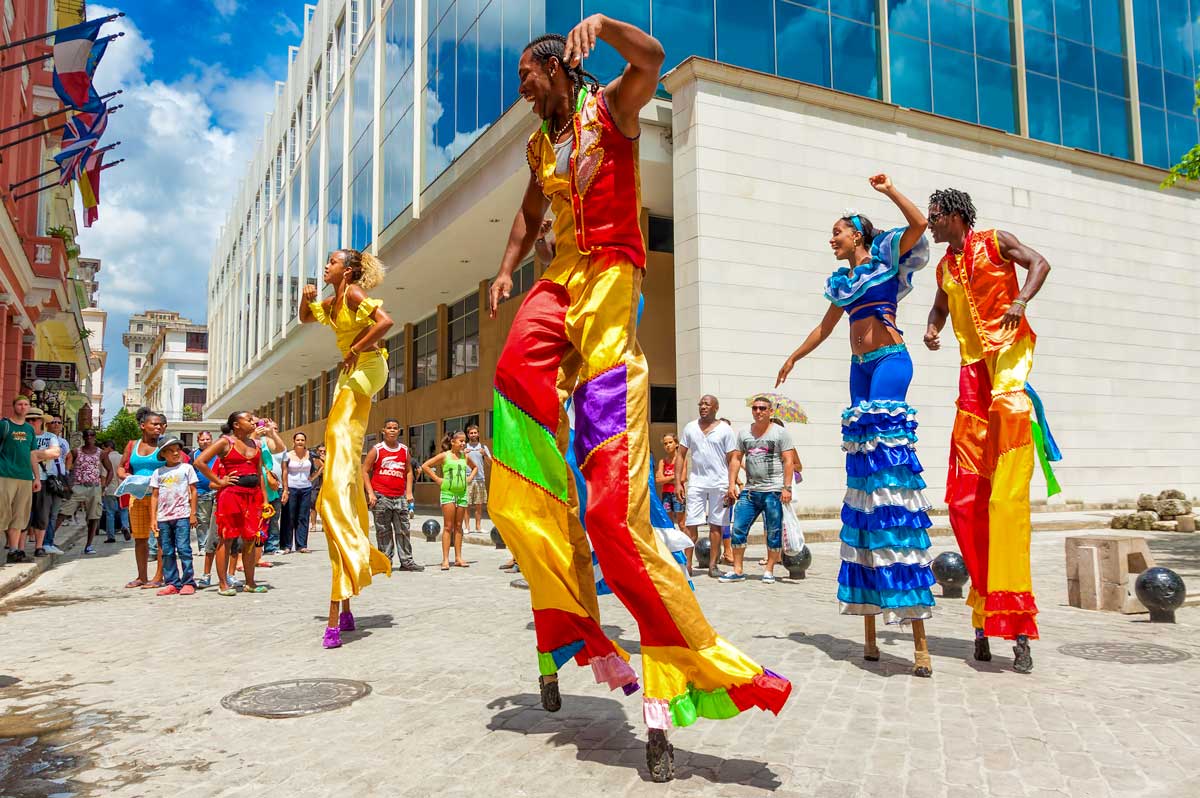
Dance performance in the streets of Havana
Festivals and Celebrations
Cuba is much more than its countryside. Its cities host a variety of festivals, summits, and parades that can be just as fascinating – it all depends on what you are looking for. From street parties to the chance of experiencing the biggest stars of vintage rhythms, it all depends on when you come.
Here are some of the highlights to look forward to:
January: The year kicks off with the country-wide celebrations for the Anniversary of the Revolution. In Havana, this is followed by the International Jazz Festival, which brings some of the genre’s biggest stars to the city.
February: The Habano Festival is all about one of the country’s top exports. You can visit Cuban cigar factories and tobacco farms, attend seminars, or book special cigar dinners that blend signature aromas with the right food pairings.
March: The largest Carnival on the island is held at Santiago de Cuba. Parades can easily last until 3 AM, but the party usually continues until sunrise.
April : The International Biennial of Graphic Humor, held at San Antonio de Los Baños, gathers cartoonists and satirists worldwide.
May : The Romerías festival combines a Spanish harvest festival with religious rituals. The town of Holguín dons its best clothes for a series of free concerts, parades, and a collective pilgrimage atop the local hill.
June : Head to Trinidad for the Fiestas Sanjuaneras or San Juan fest , which marks the longest day of the year. Dance to some of the oldest forms of African music still alive and beating.
July : During the Fiesta del Fuego (Fire Festival), the city of Santiago de Cuba loses itself in revelry to welcome back the Nzambi Congo , an ancient African deity, who is then paraded through the streets.
August : Havana’s International Hip-Hop Festival (Urban Potaje) takes place on the second week of August, just as the Havana Carnival cools down on the 7th.
September : The Feast of Our Lady of Charity (La Virgen de la Caridad) offers an unusual window into the island’s traditional religious fervor. As she is the island’s Patroness, expect her Feast to open the gates of every colonial church in Havana.
October : The International Ballet Festival of Havana may provide a window for traditional dancers, but in the smaller city of Matanzas, you can dance to the faster rumba rhythms during the Rumbero Bailador Fest.
November : In Majagua, the Red and Blue Bands Party divides the population into two teams for sports competitions, food fairs, and traditional dances.
December : In the city of Remedios, Christmas carols are replaced with Parrandas, loud and boisterous competitions in which each neighborhood prepares a special “surprise” while trying to spoil their rivals’.
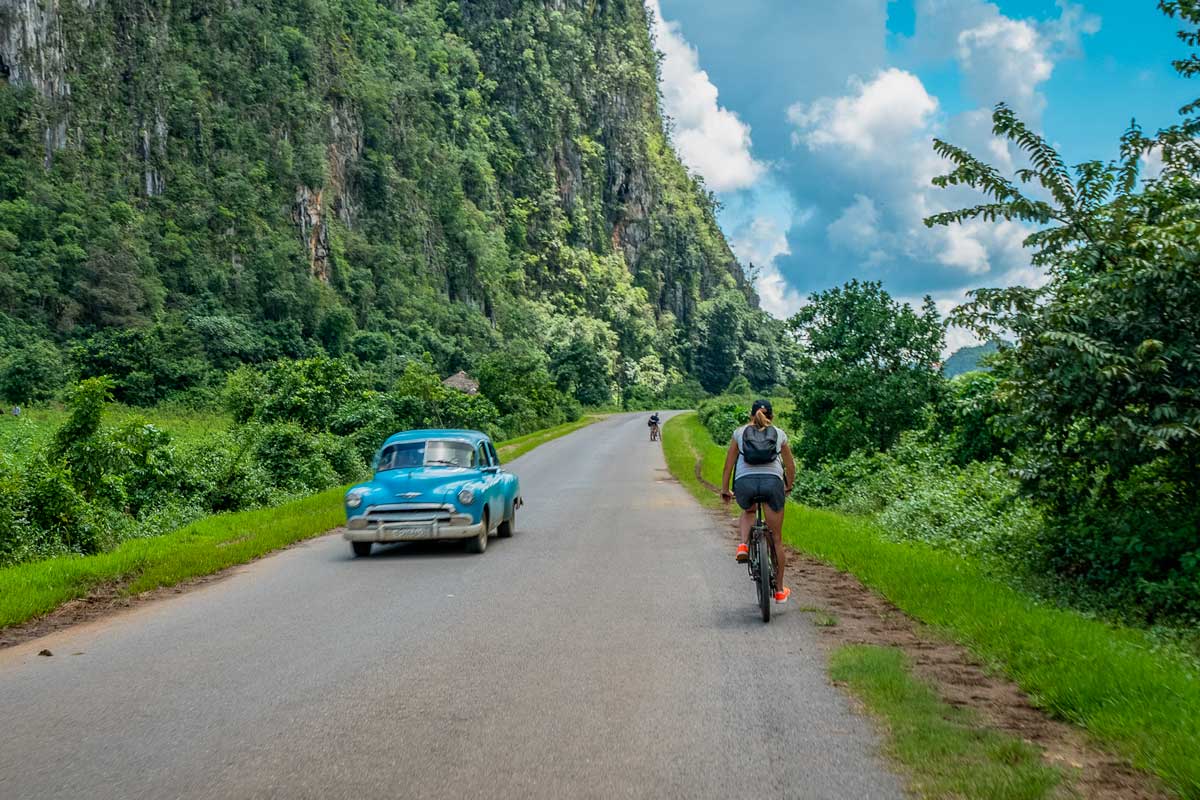
Mountain biking in Viñales
Outdoor Activities
If you need sunshine and fresh air to recharge, you may have a harder time choosing the ideal dates for your trip – especially if you are booking months in advance. These activities will depend heavily on the day’s weather, which is particularly unpredictable in Cuba.
However, that doesn’t mean that some dates won’t increase your chances of success. Here are a few considerations:
- - Planning to hike, camp, or mountain bike? Then try to come during the dry season. During the rainy season, trails may be muddy, and some parts of the countryside may be inaccessible just as you’re passing by.
- - Snorkeling and scuba diving technically just need a sunny, beach-worthy day. Try to leave a couple of “free” days on your schedule so you can rebook any activities.
- - The fishing season in Cuba goes from March to June. If you’re interested in a specific species, check with your tour operator, and expect to “capture and free” your catch!
- - If you want to sail or surf, avoid hurricane season. Even if no hurricane is headed for the island directly, one passing through a nearby island could make the Coast Guard keep you ashore.
Written by Liz Lezcano.
Published October 2022.
Looking for some cool things to do?
Visit chinatown in havana.
Visit the only Chinatown in Cuba, right in Central Havana,
The Landscape of Cuba: Topes de Collantes
Enter and Explore Topes de Collantes. Home to amazing waterfalls
Cayo Coco: The Ideal Cuban Paradise
Of all the Cuban islands, Cayo Coco has some of
Visit the Museo de la Revolución, and Relive the Fight for Cuba
Havana’s Museo de la Revolución offers a thorough look at
Best Spots for Fishing Around Cuba
Largely untouched and diverse, Cuba is one of the most
Lesser Known Parts of Cuba to Discover This Year
Escape the crowds and Look further into the Cuban landscape
Dance to Your Own Beat at Havana World Music 2022
Havana World Music: Are you ready to break beyond the
Sip and Dance Your Way Through Trinidad’s Nightlife
Things To DoSip and Dance Your Way Through Trinidad's Nightlife
Step Back in Time at Finca Vigía – Hemingway’s Home in Cuba
Visit the Ernest Hemingway home in Cuba that attracts followers
Marabana – Havana’s Annual Marathon
The Marabana, Havana’s annual marathon, is a unique opportunity to
Subscribe to our newsletter
Get more travel inspiration, tips and exclusive offers sent straight to your inbox
I would like to get Visit Cuba newsletters in my inbox
Paradise for Your Inbox
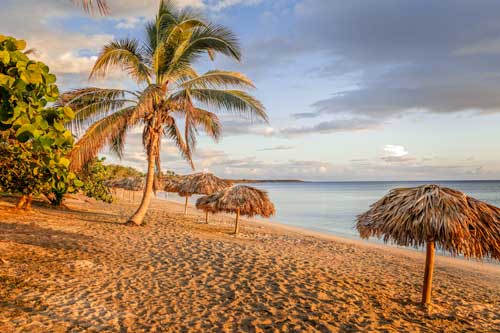
- Best time to visit Cuba
Book your individual trip , stress-free with local travel experts
- roughguides.com
- Central America & the Caribbean
- Travel guide
- Itineraries
- Local Experts
- Travel Advice
- Accommodation
Plan your tailor-made trip with a local expert
Book securely with money-back guarantee
Travel stress-free with local assistance and 24/7 support
Our time in Cuba was a wonderful experience.
- When is the best time to visit Cuba?
Perhaps you’re lured to Cuba by the promise of sun-kissed beaches , and snorkeling or diving at Cuba’s world class diving sites. You may be enticed by Cuba’s colourful and time-warped colonial towns, its lively atmospheric cities, its beautiful mountain landscapes. Maybe it’s the sensuousness of salsa that attracts, or the intoxicating carnival celebrations. Or perhaps you just want a glimpse into the unique Cuban way of life. Chances are it’s a combination of these. So for a bit of everything that covers the island, when is the best time to visit Cuba?
Climate in Cuba
Best month to visit cuba, visiting cuba in the dry season, visiting cuba in the rainy season, when to go for festivals, tailor-made travel itineraries for cuba, created by local experts.

15 days / from 2938 USD
Cuba - Family, Beach, and Culture
Enjoy a 2-week family adventure visiting highlights and hidden gems of Cuba. Marvel at the colonial architecture in Havana, enjoy a ride in a Classic Car, explore the forests close to Trinidad, and relax on white sandy beaches of Cayo Levisa - this trip packs it all into one itinerary.

5 days / from 999 USD
A moderately challenging cycling holiday through Cuban countryside visiting the tobacco fields of Viñales Valley and a pristine Caribbean beach in Cayo Jutias.

13 days / from 3483 USD
Western and Central Cuba by E-bike
Combine a leisurely activity with an insight into some of Cuba’s most fascinating cultural highlights on this new e-biking tour of Western and Central Cuba. Explore the tobacco region of Viñales, cycle along the Bay of Pigs and relax on the fine sandy beaches of Cayo Las Brujas.
Tailor-made trips for Cuba
First of all, there is no wrong time to visit Cuba, as such. But there are a few factors to take into account, chief among them is the weather. Cuba has a hot and sunny tropical climate, with dry and wet seasons: the dry season runs from November to April; the wet season from May to September. However, even during the wet season, you can still expect balmy temperatures, and the downpours never last that long. But assuming you want the least amount of rain, and the most amount of sunshine, the dry season is generally the best time of year to visit Cuba.
Broadly speaking, in terms of rainfall and temperature, the dry season months of March and April are the best months to visit Cuba. It’s dry and warm during this time, with average temperatures sitting at 27-29˚C during the day, and comfortable at night around 19-21˚C.
Other considerations affecting when to go to Cuba
There are factors besides the weather to take into account for figuring out when to visit Cuba. The peak tourist season in Cuba runs roughly from mid-December to mid-March, and all of July and August. Prices are highest and crowds thickest in summer, when the holiday season for Cubans gets under way.
As much of the atmosphere of the smaller resorts is generated by tourists, Cuban and foreign, out of season they can seem somewhat dull – although you’ll benefit from lower prices. The cities, particularly Havana and Santiago , are always buzzing and offer good value for money throughout the year.
Compared to the all-out celebrations in other countries, Christmas is a lowkey affair in Cuba, with the emphasis on private family celebration. New Year’s Eve, also the eve of the anniversary of the Revolution, is much more fervently celebrated. And if you’re going to base your trip around one key event, carnival in Santiago, held each year in July, is unmissable.

Playing guitar in Trinidad, Cuba © Ellie Matsanova/Shutterstock
The dry season in Cuba falls roughly from mid-November to April. This is when dry weather matches sunny days and warm temperatures across the island. So if it’s wet and cold where you are and you’re looking to thaw out, this is the best time to travel to Cuba.
Visiting Cuba in December – February
In the winter months of January and February the mercury can drop as low as 15˚C, and even lower at night. If you intend to go into the mountains it’s advisable to pack something warmer than a T-shirt. The cooler temperatures make for good sightseeing though, although it’s perhaps less ideal for sun worshippers hoping to bake on one of Cuba’s soft sandy beaches.
January and February are great months to visit the sixteenth-century town of Trinidad and Sancti Spíritus , and Santiago , with temperatures sitting around a not too fierce 28˚C.
Bear in mind that prices spike over the Christmas period and you’ll need to book well ahead if planning to travel to Cuba at this time.
In terms of cultural events happening around now, there are a few biggies. The ten-day film festival (Internacional del Nuevo Cine Latinoamericano Festival) kicks off in Havana in early December and is one of Cuba’s top events, and the Bienal de la Habana (Havana biennale) showcases the best in visual arts. Cubans go all out for New Year, which also celebrates the triumph of the Cuban Revolution, and mid-January sees the excellent Havana International Jazz Festival. Find out more about festivals in Cuba .
Visiting Cuba in March – April
March and April are the best months to visit for long days of sunshine and dry weather. It’s the perfect time to lay down your towel on one of Cuba’s picture perfect beaches, such as Playa Ancón, or Playa Los Pinos on Cayo Sabinal – or if you’re after a livelier scene, Varadero.
Those wishing to try diving at some of Cuba’s top diving spots will enjoy optimum conditions, such as those around the Jardines del Rey , María La Gorda and Cayo Largo .
It’s also an ideal time to explore inland Cuba, such as the Parque Nacional Alejandro de Humboldt, which has ideal trekking conditions in March. The idyllic eco hill resort of Las Terraza and the surrounding hiking terrain also make for a wonderful stopover at this time of year. And the Viñales valley and the peaks of the Sierra Maestra would be great additions to your itinerary.
It’s worth considering it’s also peak season in Cuba – reflected in the rise in cost of flights and accommodation, especially during the Easter holidays, so we advise booking ahead as far as possible.

Production of handmade cigars © Tatiana Gordievskaia/Shutterstock
If you visit in the summer, and more broadly between May and October, considered the wet season, expect it to rain on at least a couple of days over a fortnight. Don’t let this put you off, though. Although it comes down hard and fast, rain rarely stays for very long in Cuba, and the clouds soon break to allow sunshine through to dry everything out. There’s also perhaps a good trade off: rain means fewer visitors – so you can be more spontaneous when it comes to booking tours, accommodation and so on. And if you prefer a quieter time during your trip, it’s a win-win situation.
Eastern Cuba tends to be hotter and more humid during this part of the year, while the temperature in the area around Trinidad and Sancti Spíritus also creeps above the national average.
Visiting Cuba in May – August
The rainy season is just beginning in May, but doesn’t really get underway until the end of July or early August. Even then, you’ll most likely still get plenty of clear days. And if you want to get in some beach action you’ll most likely avoid the rain if you get there earlier in the day. May and June temperatures make for comfortable travel.
July through September sees temperatures soar to around 32˚C in Havana and Pinar del Río . Eastern areas, such as Santiago de Cuba, experience sweltering heat of around 33˚C.
If you don’t mind a little rain and potential sogginess you can seize the opportunity to enjoy the outdoors in June and July – before temperatures soar in August. Visitor numbers are fewer and it’s easier to find good casa particulares. Horseriding in the Viñales valley is a great way to explore the area at this time – horses make light work of the mud!
For festivals , July and August are the best times to be in Havana and Santiago. Both are settings for the vibrant annual carnival, and worth organising your itinerary around these lively, joyous events. Santiago is also host to the Fiesta del Caribe Santiago de Cuba, a week-long celebration of Caribbean music and dance, at the beginning of July.
Prices rise in July and August and it gets noticeably busier, as this is when Cubans traditionally take their holidays. However, the more low-key resorts come to life during this time, whereas off season the cultural activities and liveliness generated by visitors tapers off.
Visiting Cuba in September – November
September and October are the most threatening months of the annual hurricane season that runs from June to November, particularly in coastal areas. Compared to other Caribbean islands and some Central American countries, however, Cuba has so far held up relatively well even in the fiercest of hurricanes. Bear in mind though that rural areas are more vulnerable and hurricanes can cause some mountain trails and national parks to close.
Wet weather, humidity and hurricanes aside, if you’re keeping an eye on the cost and perhaps want to experience Cuba during the quieter months, September and October are good times to visit. You can dig out decent deals on everything from flights and accommodation, to tours.

Street musician in Trinidad, Cuba © Delpixel/Shutterstock
Cuba is brimming with festivals and cultural events , celebrating everything from music and dance, film and theatre, the Cuban revolution – and cigars! Basing your trip around one of these can help you decide when to go to Cuba.
Here are just five of Cuba’s standout festivals:
- Festival Internacional del Nuevo Cine Latinoamericano ( Havana film festival). One of Cuba’s top events, combining Cuban, Latin American and Western films with the classics, plus networking opportunities. Ten days in December
- Havana International Jazz Festival. Pulls in huge talent and combines large concerts with impromptu street jams. Mid-January
- Carnival, celebrated in small towns and big cities alike. The biggest, and not to be missed, is in Santiago de Cuba – a riot of colour and music and partying into the small hours. July
- The Festival del Habano (Cuban Cigar Festival) in Havana and Pinar del Río . The opportunity to visit cigar factories and tobacco plantations – as well the chance to sample the goods! February
- Bienal de la Habana (Havana biennale). Month-long series of exhibitions celebrating work of Cuban, Latin American, Caribbean, African and Middle-Eastern artists. April–May
Read more on festivals in Cuba .
Top image: Playing trumpet in Viñales © Nadezda Murmakova/Shutterstock
The Rough Guides to Cuba and related travel guides
In-depth, easy-to-use travel guides filled with expert advice.
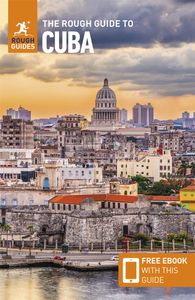
Travel advice for Cuba
From travel safety to visa requirements, discover the best tips for traveling to Cuba
- Eating and drinking in Cuba
- How to get to Cuba
- Getting around Cuba: Transportation Tips
- Travel Tips Cuba for planning and on the go
Find even more inspiration here

- Travel Tips
written by Rough Guides Editors
updated 26.04.2021
Ready to travel and discover Cuba?
Get support from our local experts for stress-free planning & worry-free travels.
- Where to stay
- Travel advice
What Americans need to know about traveling to Cuba
Making sense of the new travel policies and rules..

This year, Cuba ranked as the top trending destination in the 2023 Travelers' Choice awards , meaning Cuba-focused pages on Tripadvisor are seeing an increase in year-over-year activity.
But having swung back and forth throughout the last three American presidencies, the rules about visiting Cuba can be confusing, and it can be hard to keep them straight. Here’s what U.S. travelers need to know about planning a trip there now.
How has travel to Cuba changed in recent years?

American tourism on Cuba has been limited for decades, but in 2016, former President Barack Obama propped the door open, allowing everyday Americans to plan "people-to-people" trips—trips to visit with Cubans and learn about Cuban culture—on their own. (Previously, travelers could only visit with approved tour operators.) After decades of pause, cruises and commercial flights also resumed service to Cuba in 2016.
The following year, former President Donald Trump reversed that policy , eliminating the people-to-people option and organized group travel; banning cruises; and prohibiting U.S. airlines from flying into any other Cuban city besides Havana. Trump did, however, leave the door open for travel under the broad banner of "Support for the Cuban People," which, per The Washington Post , "required more direct aid to locals on the ground."
In 2022, President Joe Biden announced plans to resume people-to-people group travel in Cuba in a new capacity, though concrete details have yet to be released. (Individual travel is still restricted.) Biden also greenlit commercial flights to Cuban cities other than Havana to resume (though cruises are still banned).
What about now? Can Americans actually go to Cuba?

Yes. But not in typical tourist fashion, meaning you can’t fly to a beach resort and flop down the way you can in other Caribbean countries. But per the Code of Federal Regulations (CFR), Americans are allowed to travel to Cuba for a dozen state-sanctioned purposes, including family visits, journalistic activity, educational or religious activities, humanitarian projects, and Support for the Cuban People. It’s precisely that last banner under which many Americans travel to Cuba, and those types of trips must have a full-time schedule of activities sponsored by human-rights organizations or other organizations that promote democracy and/or civil society in some way. The activities must "[e]nhance contact with the Cuban people, support civil society in Cuba, or promote the Cuban people's independence from Cuban authorities," per the CFR . Again: no lazy days on the beach.
Rules put in place by the U.S. government prohibit Americans from interacting with businesses owned by or affiliated with the Cuban government; to do so would be a violation of a decades-old trade embargo. That makes many hotels—which, in Cuba, are largely government-owned or government-affiliated—off limits (you can find the list of banned hotels on OFAC's restricted entities list ).
Instead, Americans are required to stay in casa particulares , civilian-owned, guesthouse-like private residences, dine at privately owned restaurants ( paladares ), and shop at privately owned stores owned by non-state-affiliated proprietors ( cuentapropistas ).
Which visa or documents do I need to travel to Cuba?
Cuba requires that all visitors have a visa before arrival. If you're visiting under the "Support for the Cuban People" category, you will need a tourist visa—also known as a tourist card—which grants up to a 30-day stay. (The visa options are listed out on the Embassy of Cuba website .)
The most common way to acquire a tourist visa is through your airline; you can purchase visas (usually between $50 and $85) at the airport before the flight. Because policies vary, be sure to confirm the details before your trip. You can also purchase Cuban tourist visas online through third-party companies or in-person at some Cuban consulates (call ahead to find out whether the nearest consulate offers them). Keep in mind: You will need to prove, typically in the form of a return plane ticket, that you’re planning on exiting Cuba before the visa expires.
Cuba also requires travelers to purchase non-U.S. health insurance, which is typically provided by your airline and included in the airfare. Otherwise, you can purchase it at the airport upon arrival in Cuba. Because of the pandemic, you must also fill out a health declaration form .
All of these rules can change quickly—and sometimes without warning—so it’s important to confirm policy specifics with the Embassy of Cuba before your trip.
On the U.S. side of the equation, there is no paperwork and you don't need to apply for a special license if you plan to travel to Cuba under one of the 12 approved categories. But you must carry an itinerary with you at all times that proves the purpose of your visit. You must also retain documentation of every transaction you make in Cuba for five years after your visit, which you may have to provide to OFAC if requested. Because these rules can change at any point, confirm them with the U.S. Department of State and OFAC before your trip.
Which US airlines fly to Cuba?

In June 2022, Biden opened air travel to other Cuban cities besides Havana , including the beach-resort town of Varadero and historic city of Santiago de Cuba. Today, American Airlines, Delta Air Lines, JetBlue Airways, Southwest Airlines, and United Airlines all run flights to Cuba from the U.S. Gateway cities with nonstop flights include several Florida cities, including Miami, as well as Houston and New York City.
What about currency and connectivity in Cuba?
- There is Internet in Cuba, but it's widely known to be limited and slow. You will likely have to pay by the minute, and prices vary.
- Many U.S.–based cell phone providers offer roaming coverage in Cuba, but check with your specific provider.
- Credit and debit cards issued by American banks are not widely accepted in Cuba, and many businesses may not have an infrastructure to support international transactions, so you should bring cash and exchange it upon arrival at the airport, a bank, or a casa de cambio (CADECA) exchange house.
- The only currency in Cuba is the Cuban peso (CUP). The Cuban convertible peso (CUC) ended circulation in 2021. That said, many businesses accept euros.
What else about Cuba should travelers be aware of?
In July 2021, during an extreme economic crisis, Cubans staged public demonstrations, protesting their lack of access to essentials like food, medicine, and electricity, as well Covid-19 restrictions. The government retaliated by detaining hundreds of protestors, some 700 of which were still imprisoned a year later . Protests continue to flare up, even as recently as this fall .
According to Human Rights Watch , "The Cuban government continues to repress and punish virtually all forms of dissent and public criticism. At the same time, Cubans continue to endure a dire economic crisis, which impacts their social and economic rights."
Given these circumstances, Cuba is facing the largest migration crisis in the country's history. In 2022, some 250,000 Cubans —a full 2 percent of the country's total population—left the country for the U.S., marking the largest exodus since the 1959 Cuban Revolution. As of this month, the United States has restarted visa services at the U.S. Embassy in Cuba and plans to issue 20,000 visas to Cubans a year. Follow updates from the Department of State to be aware of the latest travel advisories .
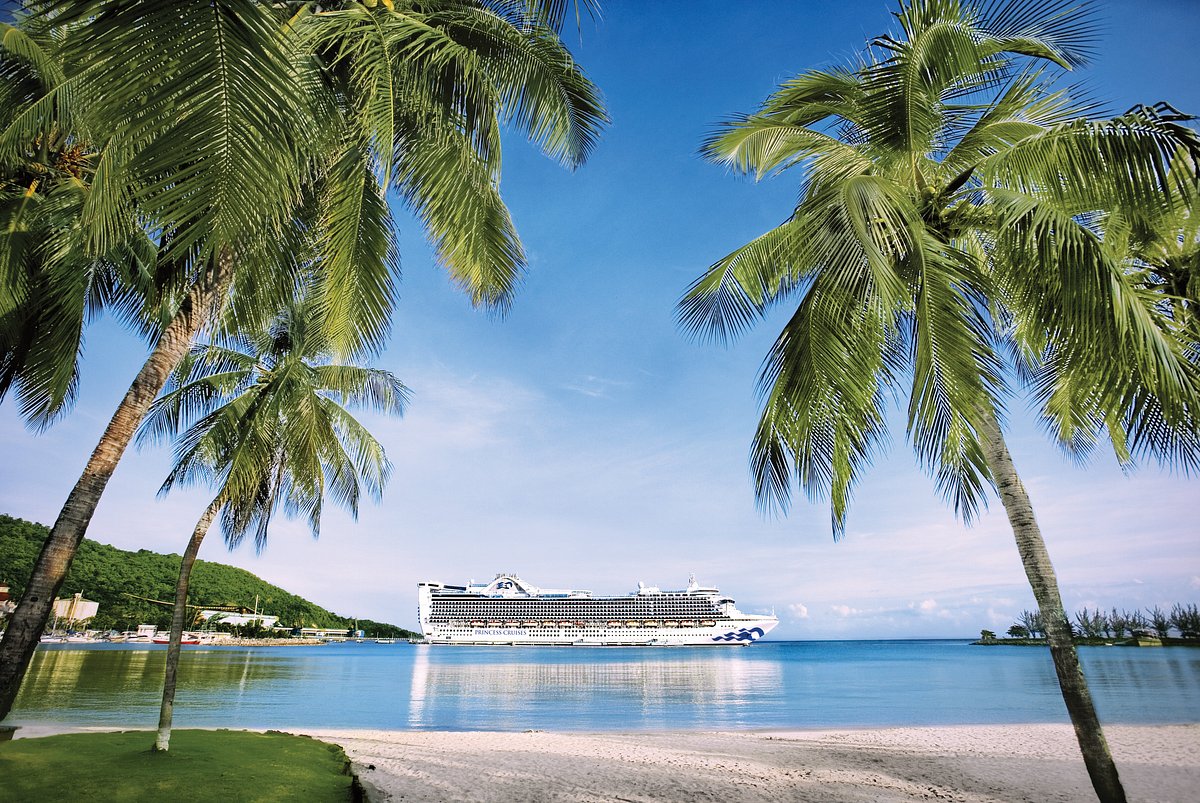

Can Americans Travel to Cuba? [2024 Legal Cuba Travel Guide]
I’m an American citizen who travels to Cuba all the time, so “can Americans travel to Cuba?” is one of the questions I’m most frequently asked related to Cuba travel. While many Americans believe that Cuba is still “off-limits” to American citizens, this couldn’t be further from the truth; there are many ways to legally travel to Cuba for American citizens.
Want to travel to Cuba from the United States – as a U.S. citizen or otherwise? Our ultimate guide to Cuba travel for Americans will show you how, answering some of the most common questions about Cuba travel safety , Support for the Cuban People travel , and more.
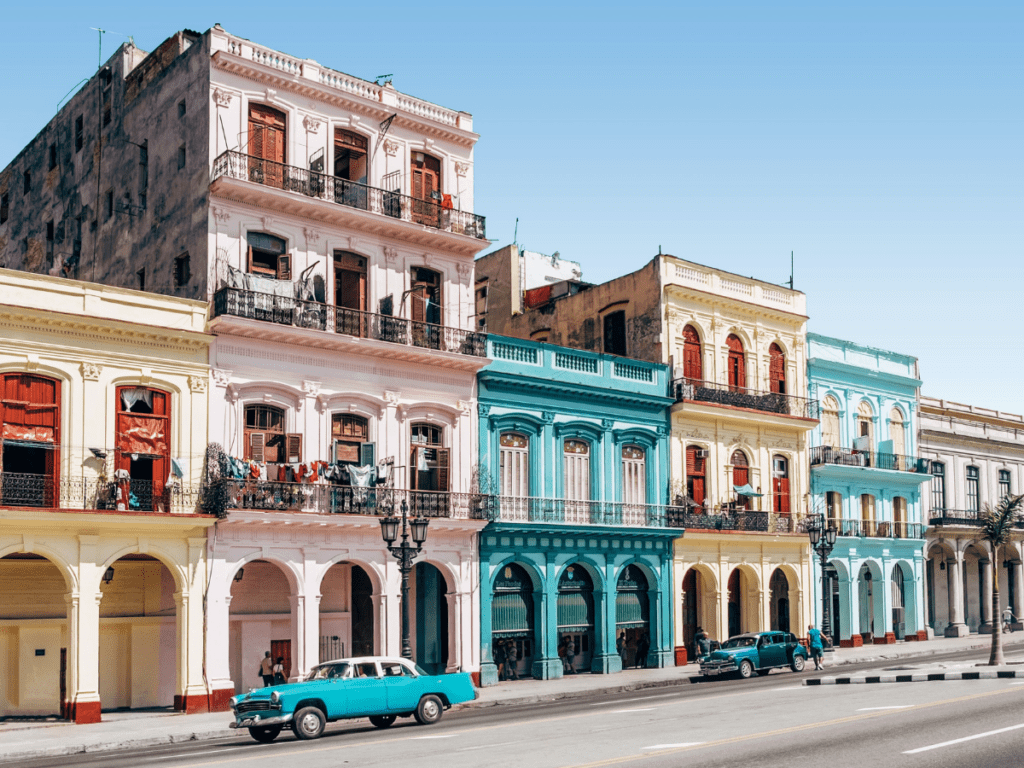
This post contains affiliate links that may reward me monetarily or otherwise when you use them to make qualifying purchases – at no cost to you. As an Amazon Associate, I earn from qualifying purchases. For more information, please read our disclosure policy .
American Travel to Cuba
The short answer to the question “can Americans travel to Cuba” is YES, American citizens can travel to Cuba.
Non-U.S. citizens are allowed to travel to Cuba via the United States as well. American citizens can fly from the United States directly to Cuba, travel independently (no need for a group trip or guided trip here!), and enjoy Cuba just as they would any other travel destination.
The longer answer to the question “can Americans travel to Cuba” is that while legal travel to Cuba is entirely possible and even quite easy, there are some important regulations around American travel to Cuba that travelers should be aware of.
U.S.-Cuba Policy Changes
For years, U.S.-Cuba travel by citizens of the United States has been restricted in many ways. In 2014, President Obama announced a new way forward in the relationship between the United States and Cuba, including lifting many of the travel restrictions that made it quite challenging for U.S. citizens to travel to Cuba.
While the subsequent Trump and Biden administrations have made slight changes to Obama’s new policies, Obama’s new Cuba policies remain mostly intact. Americans can still travel to Cuba more easily than they’ve been able to in decades .
Cuba Travel 101
- Currency in Cuba: A Local’s Guide for Travelers
- How to Get Wifi in Cuba [Updated!]
- Is Cuba Safe? Updated Cuba Safety Guide
- Ultimate Cuba Travel Guide – A Local’s Advice for Travelers
Can Americans Travel to Cuba?
Here’s why so many travelers ask us, “can Americans travel to Cuba?” – because Americans are still not able to legally travel to Cuba purely as “tourists.” Americans must still have a “reason” for traveling to Cuba.
Currently, the U.S. government doesn’t allow American citizens to Cuba as tourists. However, the U.S. government allows American citizens to travel to Cuba so long as they support local, non-government-owned businesses while in Cuba.
Essentially, yes, you can visit Cuba and travel exactly as you would anywhere else. Just avoid government-run hotels, restaurants, and tours while you’re there. This is actually incredibly easy, as all the best things to do in Cuba and the best places to visit in Cuba are local anyway!
So why might it feel like Americans can’t travel to Cuba (when it’s actually quite easy to travel to Cuba)? Americans must give a “reason” for traveling to Cuba – usually when purchasing an airline ticket or booking a hotel room.
How Can Americans Travel to Cuba?
You’ll probably need to check a box when purchasing your airline ticket asking for your “reason” for traveling to Cuba. No need to get nervous; this is easy – by stating that your trip to Cuba is in “ Support for the Cuban People ,” you’re simply acknowledging that while in Cuba, you won’t be staying at government-run hotels and the like.
It’s really that easy. Check a box on a form, and travel to Cuba.
Former President Obama’s policy changes towards travel to Cuba made this possible by creating 12 categories of authorized travel to Cuba , travel that is permitted by the U.S. government for American citizens looking to travel to Cuba. Now it’s as easy as checking a box and booking your airline ticket!
Best Places To Stay in Havana
- Casa Giraldilla ($)
- Casa Flamboyan ($ – $$)
- Residencia Santa Clara ($$)
- El Candil Boutique Hotel ($$ – $$$)
- La Reserva Vedado ($$$)
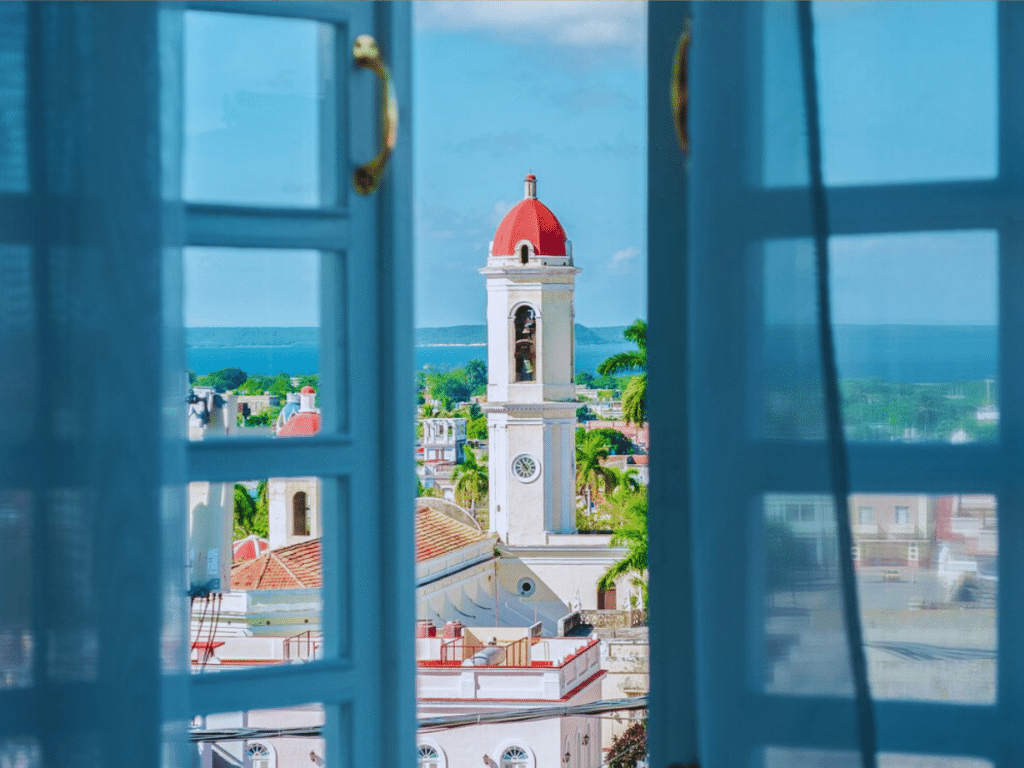
12 Categories of Authorized Travel to Cuba
Now when traveling to Cuba, you simply choose one of these twelve categories of authorized travel to Cuba that applies to your trip. Most travelers’ trips fall under the Support for the Cuban People category of authorized travel, which allows for travel to Cuba so long as it supports local businesses.
These are the Twelve Authorized Categories of travel to Cuba:
- Family visits
- Official business of the U.S. government, foreign governments, and international organizations;
- Journalistic activity;
- Professional research and professional meetings;
- Educational activities;
- Religious activities;
- Public performances, clinics, workshops, athletic and other competitions, and exhibitions;
- Support for the Cuban People ;
- Humanitarian projects;
- Activities of private foundations or research or educational institutes;
- Exportation, importation, or transmission of information or informational materials;
- Certain export transactions.
When you book your airline ticket to Cuba or book your accommodations in Cuba in advance, you may be asked your “reason” for traveling to Cuba. It’s as simple as stating “Support for the Cuban People.”
Read More: Support for the Cuban People Travel Guide
Support for the Cuban People
Most travelers looking to experience Cuba need to only offer “ Support for the Cuban People ” as their “reason” for traveling to Cuba. When you do this, it means you’re saying to the U.S. government that you acknowledge that you’re planning to spend your travel dollars with local, non-government-run businesses while you’re in Cuba – that’s it!
This is stuff that you’d be doing on a trip to Cuba anyway – which is what makes it so easy to travel normally this way.
Stay at a casa particular (room for rent or apartment for rent owned by a Cuban, Airbnb style) or a small boutique hotel, meet up with local guides, eat at any of the innovative new restaurants around the island , or experience Cuba from a local’s eyes. This is all permitted and encouraged on a “Support for the Cuban People” trip.
Travel Insurance
Cuba requires that all travelers have proof of a comprehensive travel insurance policy in order to enter the country. Check out our guide to travel insurance for Cuba for more details. We recommend these brands for Cuba travel insurance:
- Visitors Coverage : Coverage for Cuba travel available to citizens of all countries, though not currently available to residents of New York and Maryland in the United States.
- Insubuy : Coverage for Cuba travel available to citizens of all countries and states of the United States.

Regulations on American Travel to Cuba
While many continue to ask, “ can Americans travel to Cuba ?” – one of our most frequently asked questions on this website! – the answer is yes, and with these new regulations, it’s easier than ever.
However, keep in mind that some travel regulations put in place by the U.S. government still apply to American travelers visiting Cuba. These include:
- American citizens are no longer able to bring rum or cigars back from Cuba ;
- American citizens are now prohibited (by the U.S. government – not the Cuban government) from staying at a variety of hotels in Cuba ;
- Some methods of traveling to Cuba, such as “ people to people Cuba ” travel organized tours and the ability to travel to Cuba by cruise, have been scaled back or eliminated.
Read on for some of the regulations on travel to Cuba that Americans should be aware of during their trip.
Restricted Hotels in Cuba
One of the newer travel restrictions for Americans traveling to Cuba relates to places where American citizens are not allowed to stay while visiting Cuba. The Trump Administration developed a list of specific hotels and guesthouses that are either partially or entirely owned by the Cuban government and declared them off-limits to American travelers.
Check out the full list here before you book your accommodations in Cuba.
Some newspapers and websites have been incorrectly reporting that Americans are not allowed to stay in any hotel in Cuba, but this is not actually the case. Americans are just prohibited from staying in certain hotels that are owned entirely or partially by the Cuban government.
There are many boutique hotels with private ownership where Americans are still able to stay, plus private rentals called “casas particulares” or private home rentals like Airbnbs. In fact, some of our favorite hotels in Havana and around the country are still open and ready for business for American travelers ( La Reserva Vedado , La Rosa de Ortega , El Candil Boutique Hotel , and plenty of other Old Havana hotels are among our favorites in the capital).
Read More: Accommodation Guides in Cuba
- What is a Casa Particular Guest House in Cuba?
- Where To Stay in Havana, Cuba
- 10+ Best Resorts in Cuba
- 16+ Best Hotels in Cuba
Financial Restrictions in Cuba
It’s very important that American travelers to Cuba be aware of the financial and banking restrictions they will experience while traveling in Cuba. Because of the decades-long U.S. embargo against Cuba, American debit cards and credit cards will not work on the island as they do for those traveling from any other country .
That means that while American citizens can travel to Cuba, they can’t access their money from Cuba. This is quite important, as it means that if plan to travel to Cuba, you need to plan ahead and bring the money you’ll need for your trip with you in cash .
You can bring American dollars and convert them into Cuban pesos once you arrive in Cuba. Please read our complete Cuban currency guide before doing this – you’ll see why it’s not wise to exchange your money for Cuban pesos at the airport, for example, and learn how much money to bring with you on your trip to Cuba.
Read More: Financial Restrictions in Cuba
- The Ultimate Guide to Currency in Cuba
- Budget Your Trip: How Much Money To Plan To Bring to Cuba
Internet Restrictions in Cuba
There are no internet restrictions in Cuba that are specific to American travelers. However, it’s important to be aware of some important internet-related challenges in Cuba.
We get a lot of questions about whether there is internet access in Cuba , and if there is, if it’s safe to use or restricted by the government.
While the internet in Cuba is slower than you may be used to, it is now quite widespread and is pretty easy to use in most places in Cuba. Some websites are blocked in Cuba , and there have even been widespread internet outages during times of social unrest, though these blockages have mostly been of news websites that have been critical of the Cuban government.
However, the United States embargo of Cuba and the related financial and economic restrictions on U.S. companies doing business in Cuba means that some companies can’t offer their services to internet users in Cuba (notably, PayPal and many other banking apps, but the list changes) . You will not be able to access these websites from Cuba.
You can easily get around this if you want by using a VPN (Virtual Private Network) in Cuba . We recommend NordVPN – it’s by far the best VPN to use in Cuba But, even without a VPN, you can still use the internet in Cuba without too much of a hassle.
Read More: How To Use the Internet in Cuba: A Local’s Guide For Travelers
Read More: Internet in Cuba
- Guide to Using the Internet + Getting Wifi in Cuba
- Best VPN For Cuba ( + How to Use a VPN in Cuba)
Packing Restrictions in Cuba
There are some limitations worth noting about what you can bring into Cuba. While most are quite obvious – the usual dangerous substances and the like – there are a few rules for packing for Cuba , both for travelers from the United States and elsewhere :
- Travelers can not bring drones to Cuba
- Travelers can not bring devices like walkie-talkies, satellite phones, or GPS devices. Any personal computers, cell phones, cameras, or any other devices you normally travel with are absolutely fine – no worries here.
- Avoid bringing any literature to Cuba that may be seen as critical of the Cuban government. My brother was once held up in customs for bringing a university textbook with Donald Trump on the cover.
What to Pack for Cuba
Check out our Ultimate Cuba Packing List to help you pack for your trip – we’re sharing exactly what to bring to Cuba and what we never travel without.
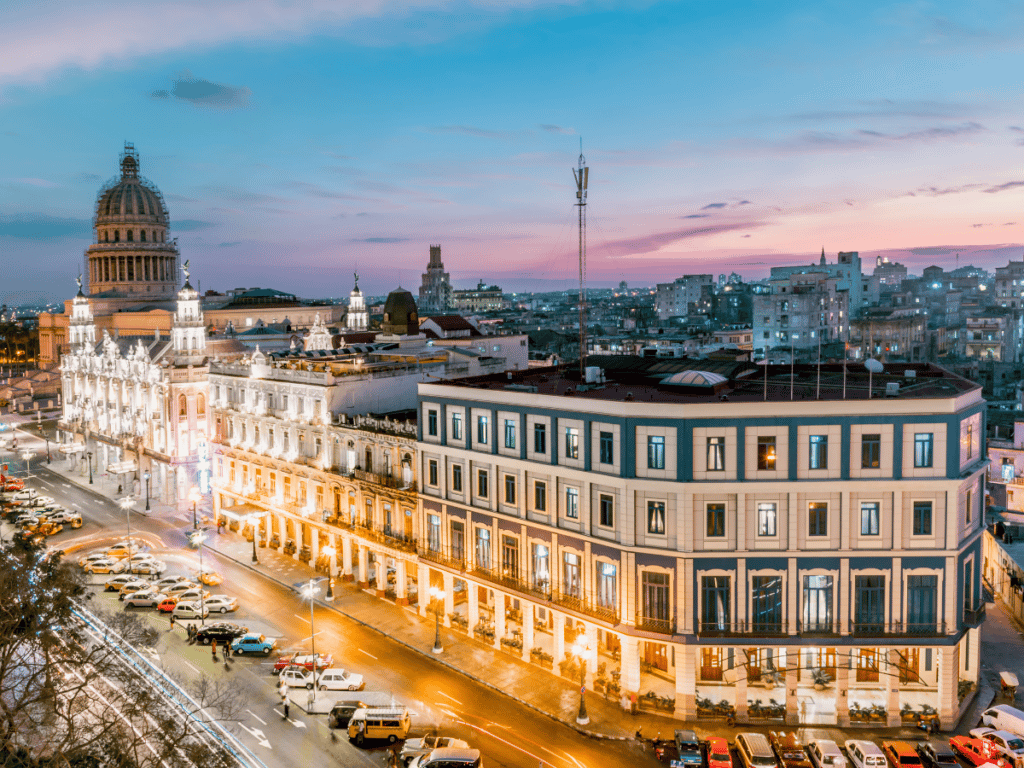
American Travel to Cuba – Frequently Asked Questions
Can americans fly to cuba.
Yes – Americans can fly to Cuba! American citizens can fly to Cuba either from the United States directly or from other countries. Flights to Cuba leave regularly from many of America’s largest cities like Miami, Ft. Lauderdale, Atlanta, and New York.
We frequently get the “can Americans fly to Cuba?” question because when travel to Cuba was more restricted, many Americans used to fly to Cuba through Canada or Mexico as a way to skirt travel restrictions .
However, flying to Cuba via another country like Mexico or Canada is no longer a necessity. Obama’s Cuba policy changes allowed many more American citizens to travel to Cuba much more easily, kicking off many more flights to Cuba from the United States.

Do Americans Have to Travel to Cuba With A Group?
One of the most popular ways to travel to Cuba prior to the Cuba travel policy changes of former President Obama was with a “people-to-people” group or as part of an educational tour. However, with the ease of traveling to Cuba from the United States now, these group travel to Cuba experiences are no longer a necessity to visit the island.
While there are groups that travel to Cuba and tout the ease of traveling to Cuba by purchasing a spot on a group trip doing so, it isn’t necessary to travel to Cuba with a group . Feel free to travel to Cuba with a group if this is your preferred style of travel – or plan your trip to Cuba independently, too!
Looking for some engaging tours in Cuba, ways to meet up with local guides, or fun activities and excursions in Cuba? We recommend Civitatis , a fantastic company we’ve used countless times before that runs tours with local guides all around Cuba.
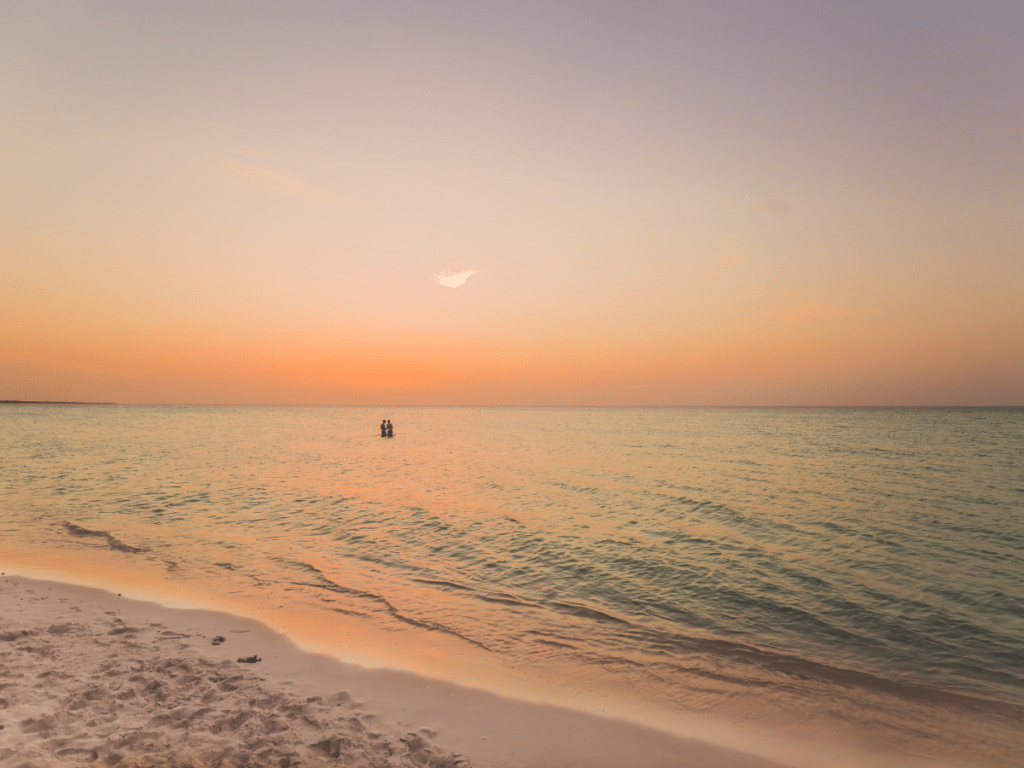
Is Cuba Safe for Americans?
While Cuba isn’t crime free, Cuba is a safe travel destination for all travelers, including American travelers. Statistics prove Cuba is quite a safe destination for travelers, and my own experience exploring Cuba, even as a solo female traveler, confirms it.
In all my years of visiting Cuba, I’ve never been met with anything other than curiosity when people leave I’m from the United States. While many Cubans disapprove of the government of the United States, I’ve never met a single Cuban who holds this against the average American citizen.
Overall, Cuba is safe for Americans , and as a traveler, you have absolutely nothing to fear while visiting.
Read More: Is Cuba Safe for Americans?
Travel Essential
Don’t think about traveling to Cuba without a good VPN (Virtual Private Network) . Using a VPN while connecting to the internet is an easy way to keep your personal information safe from hackers and trackers. We’ve used NordVPN for years and couldn’t recommend it more – it’s a must for safety online, especially in Cuba.

American Embassy in Cuba
Part of the policy changes of former President Obama in 2014 paved the way for reopening the United States Embassy in Cuba after nearly 60 years of closure. The American Embassy in Cuba offers emergency services to American citizens traveling in Cuba, including assistance with lost passports, registering births abroad, and more.
Located prominently along the Malecón sea wall in central Havana, the American Embassy in Cuba is currently providing services to American citizens and has just started providing limited services to Cuban citizens seeking visas to the United States.
As a U.S. traveler to Cuba, you should save the address and contact information for the embassy just in case you need it:
U.S. Embassy Havana Malecón, Calzada between L & M, Vedado Havana, Cuba Phone: (53)(7) 839-4100
Travel to Cuba
There are so many things to do in Cuba – much more than laying on the beach and riding in old, classic American cars.
Anything from taking a guided tour of Havana to eating at a restaurant operated as a small business or taking salsa classes are ways to enjoy Cuba. And guess what – all of these things are perfectly legal – and welcome! – when you travel to Cuba as part of a Support for the Cuban People trip.
For more travel ideas, we put together a guide to the top ten activities in Cuba for a Support for the Cuban People trip with our favorite ideas for a fantastic trip! Go ahead – get started planning your once-in-a-lifetime trip to Cuba! As always, we’ll be here to help you get started.

Carley Rojas Avila
Carley Rojas Avila is a bilingual travel writer, editor, content marketer, and the founder of the digital travel publications Home to Havana and Explorers Away. She is a serial expat and traveler, having visited 40+ countries and counting. Carley has written for publications like Travel + Leisure, MSN, Associated Press, Weather Channel, Wealth of Geeks, and more. Find her front row at a Bad Bunny concert, befriending street cats, and taste-testing every pizza in Havana.
I went to Cuba after it reopened - here’s what you need to know

Oct 27, 2020 • 8 min read
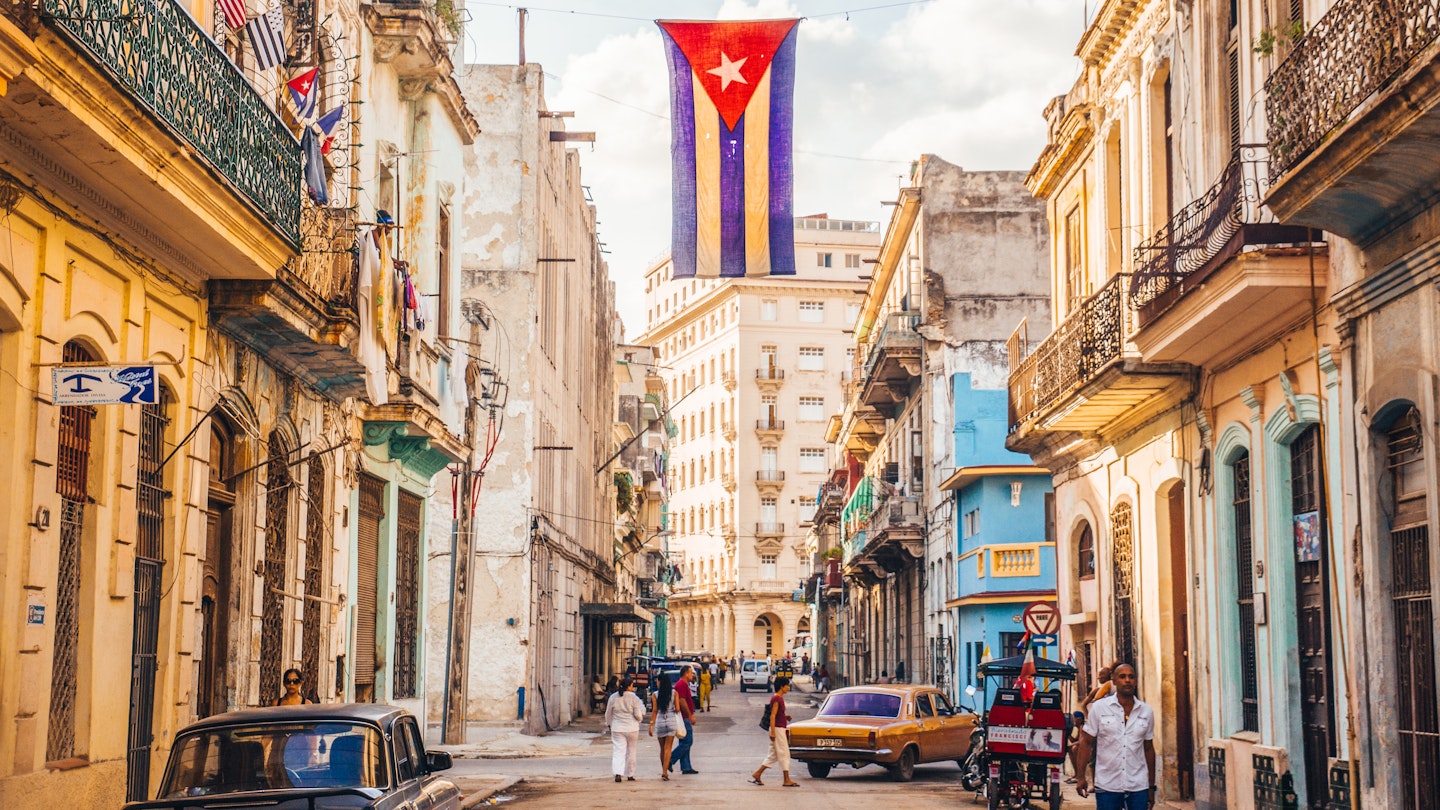
Cuba has reopened to tourists. Here's what it's like to visit © Julian Peters Photography / Shutterstock
Cuba and I go back a long way. As a Lonely Planet writer and occasional tourist, I’ve been traveling to the country for nearly 25 years, from the economic crises of the 1990s to the heady days of 2016 when President Obama and The Rolling Stones dropped by in the same month. I secretly dreamed it would be the first place I revisited when coronavirus restrictions were lifted.
The opportunity cropped up sooner than I expected. In early July, Cuba tentatively announced it was ready to reopen several of its offshore islands to tourism. Even better, to lure back nervous travelers and help boost the country’s beleaguered economy, all international visitors were to be given a free COVID-19 test on arrival.
By September, the first airplanes began flying from Canada to Cayo Coco , a large tropical key off the north coast, home to 30 all-inclusive resorts but no permanent Cuban population. Cayo Coco was to be a pilot scheme, the first stage of Cuba’s phased reopening. By screening everyone who entered, including hotel workers bused in via a causeway from the Cuban mainland, the government would create a unique COVID-free vacation zone.

Booking my trip
After scouring the internet for deals and flight information, I made a booking with Air Canada, the first Cuba-bound airline to reactivate flights in September. My package included return flights from Vancouver , a mandatory hotel reservation and special COVID-19 medical insurance. All in, my trip cost CAN$912 (US$693 at current exchange) – that's hotel (including food and drink), bus transfers, return flights from Vancouver and insurance. But rates may start going up in November.
For this trip, at least, I would be confined to an all-inclusive resort strip off Cuba’s north coast with no access to the mainland. Nevertheless, the journey still had some inherent risks. A positive COVID-19 test at the airport would leave me facing up to two weeks in a Cuban hospital. Similarly, when the fun was over, I would have to endure 14 days of quarantine back home.
Weighing up the pros and cons, curiosity prevailed over indecision. In the unpredictable world of travel writing, journeying into the unknown is part of the job description. I loaded up on hand sanitizer, obtained a good mask for the plane and got ready to head south.
Cuba and the pandemic
In the global battle to mitigate coronavirus, Cuba has emerged as the New Zealand of the Americas: the country currently has the lowest death rate (per million inhabitants) in Latin America. In a nominally socialist country, state control and central planning has helped stem the flow.
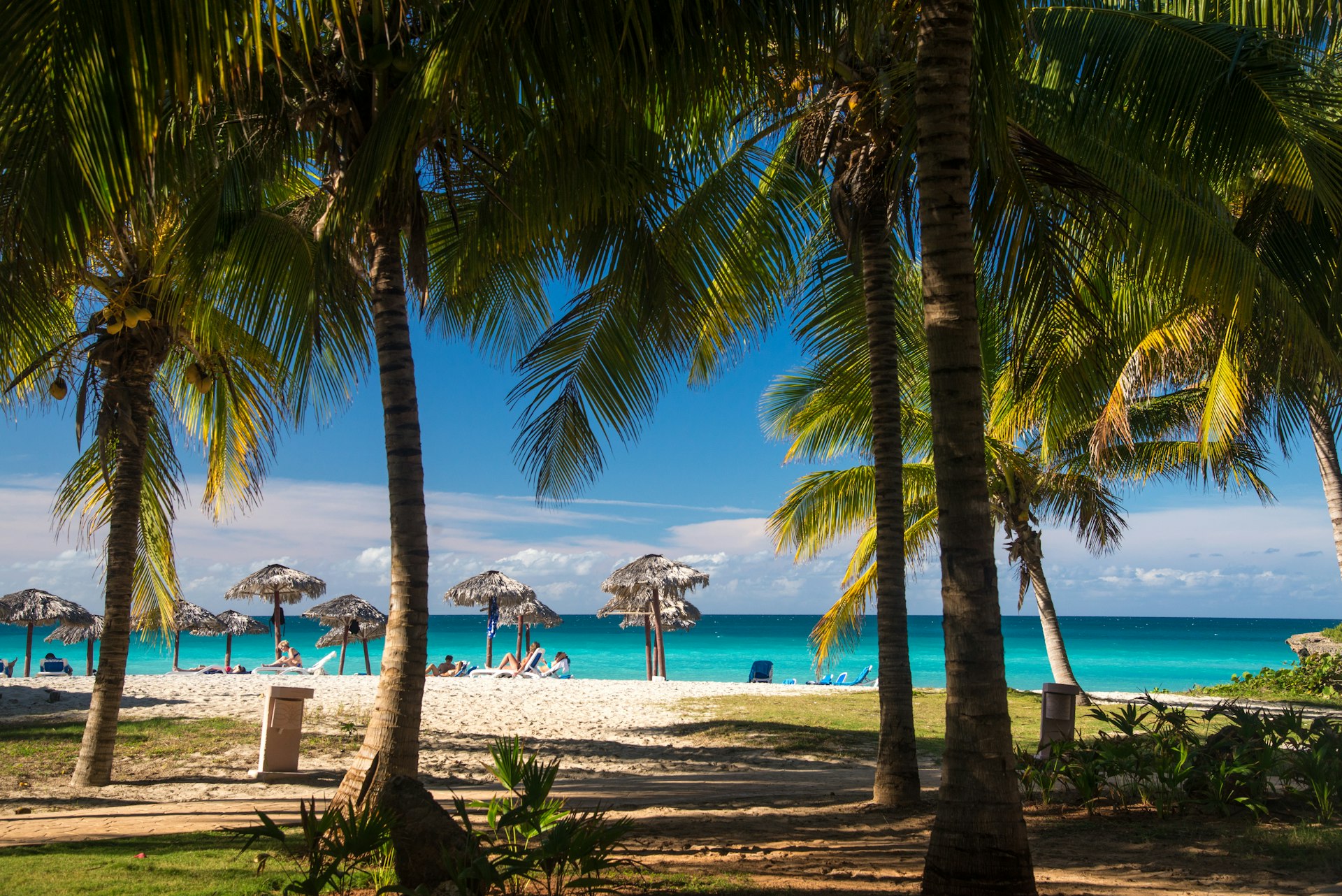
"Cuba has overcome the pandemic thanks to a 'prevention and control' plan, prepared in January 2020," Roy Perez in Santiago de Cuba explained to me when I contacted him by email for some pre-trip advice. "The plan included training medical staff, preparing quarantine facilities, implementing special contact-tracing processes, and informing the public (including tourism workers) about symptoms and precautions.
"Medical students went door to door to screen thousands of people daily. Masks remain mandatory, and the fines for being caught without one are pretty stiff."
Roy is the co-owner of Roy’s Terrace Inn , a private homestay and restaurant in Cuba’s second city. Prior to my trip, I asked him and another friend, Luis Miguel in Havana how Cubans felt about tourists returning when the country fully reopens, possibly as early as December.
"Economically speaking, Cubans are more than ready for visitors to return." Roy said, "While there’s an underlying fear that reopening could lead to further COVID-19 outbreaks, I think 90% of Cubans are willing to take the risk."
Luis Miguel, who runs Casa 1932 , an art deco-themed homestay in Centro Havana, agreed. "I have kept my business closed in line with the country’s COVID-19 protocols, but after carrying out some renovations over the summer, I am ready to start offering my services again, this time with higher quality and new standards of hygiene."
Roy also hopes to reopen soon: "Now that the COVID-19 measures have been eased, we certainly will open the business again. In fact, we already have some bookings for November, December and January from Canadian, Italian and German guests. We are super happy to say we’ve had zero COVID-19 cases in Santiago for over two months."

Arriving in Cuba
Braced for my own trip, I arrived at a deserted Vancouver airport on a Friday night in mid-October for the red-eye to Toronto, my first flight since the beginning of the pandemic. Though relieved to see the plane’s middle seats had been left empty, I still felt paranoid enough to pull on two face masks and hold my bladder for an agonizing four-and-a-half hours until we landed (thoughts of a Cuban hospital stay had me spooked).
By bizarre contrast, the connecting flight in Toronto was jammed full. Sitting elbow-to-elbow with 200 COVID-weary Canadians, I metaphorically held my breath for three hours as we coasted over the US and the Straits of Florida arriving five minutes early at Cayo Coco’s Jardines del Rey airport to a relieved round of applause.
The disembarkation was quick and smooth. First, our baggage was sanitized on the runway; then we were filtered through an air-conditioned lounge for a blink-and-you’ll-miss-it COVID-19 test (two swabs up the nose, one in the throat). Next, it was through customs, security, baggage collection and a final temperature test before we exited the airport. The whole airplane was processed in less than an hour. It was an impressive start.
The Cubans were extremely happy to see us. The pandemic combined with a recently tightened US embargo has hit the already weakened economy particularly hard. Tourism accounts for over 10% of Cuba’s GDP and Canadians make up nearly one-third of all tourists. We were enthusiastically welcomed with smiles, music, dance, and rum cocktails.
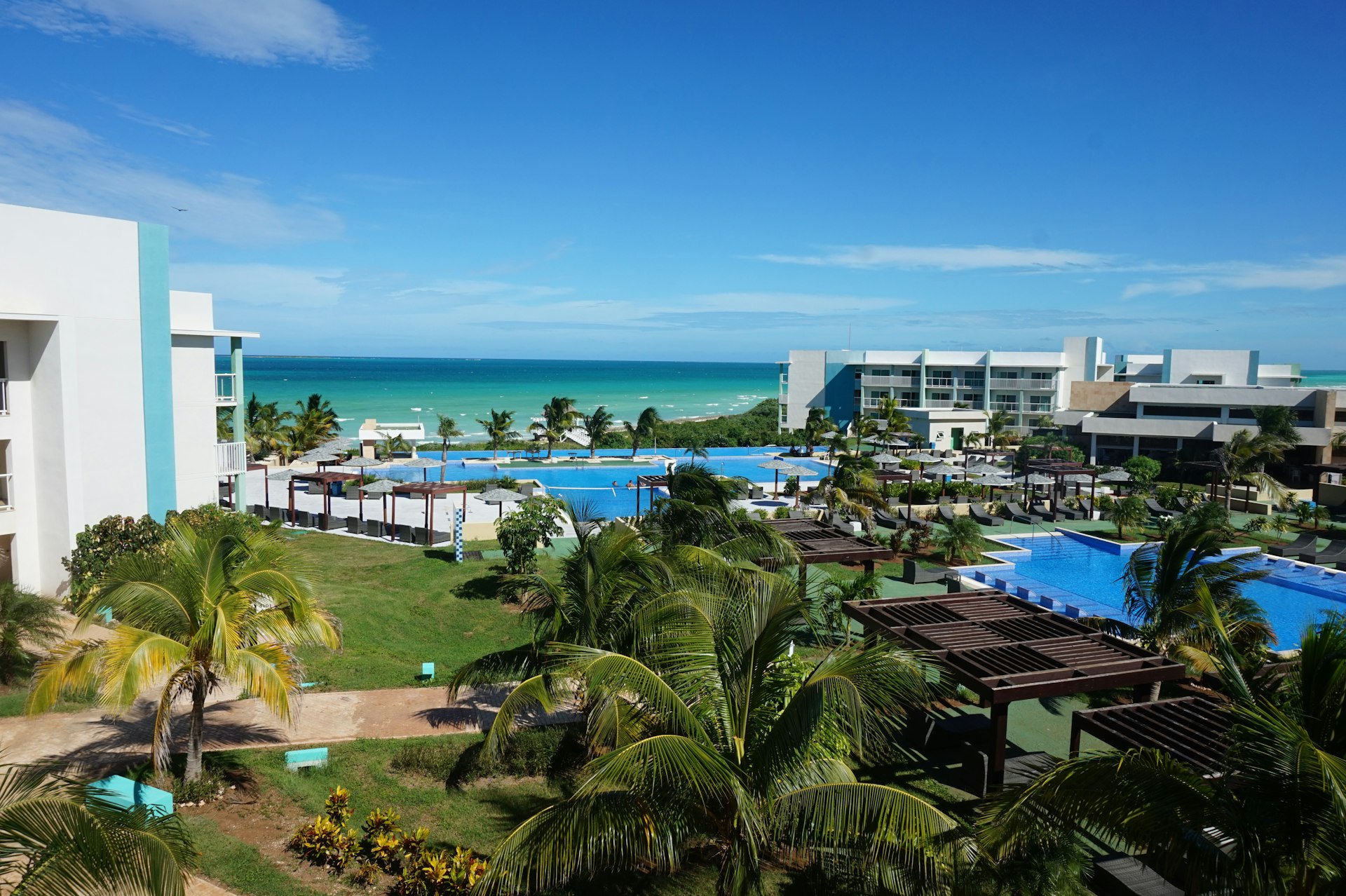
A surreally empty hotel
I was staying at Hotel Gran Muthu , a 500-room resort on Cayo Guillermo, Cayo Coco’s beach-rimmed smaller sibling, where there were only 26 other guests. What would normally resemble a noisy holiday camp, became a tranquil monastic retreat in a pleasant tropical island setting with better food and more gregarious service (staff outnumbered guests by about three to one).
For the first day masks remained mandatory, but after the arrival of our COVID-19 test results the following morning (everyone tested negative), they were peeled off with barely suppressed glee. I had almost forgotten what it felt like to stand next to a stranger and have a face-to-face conversation.
For the next seven days I reveled in my idyllic tropical cocoon, roaming deserted beaches, looking for flamingos in briny mangrove swamps, troll fishing for barracuda and reading Hemingway. It felt about as safe as you could get in a world preoccupied with coronavirus.
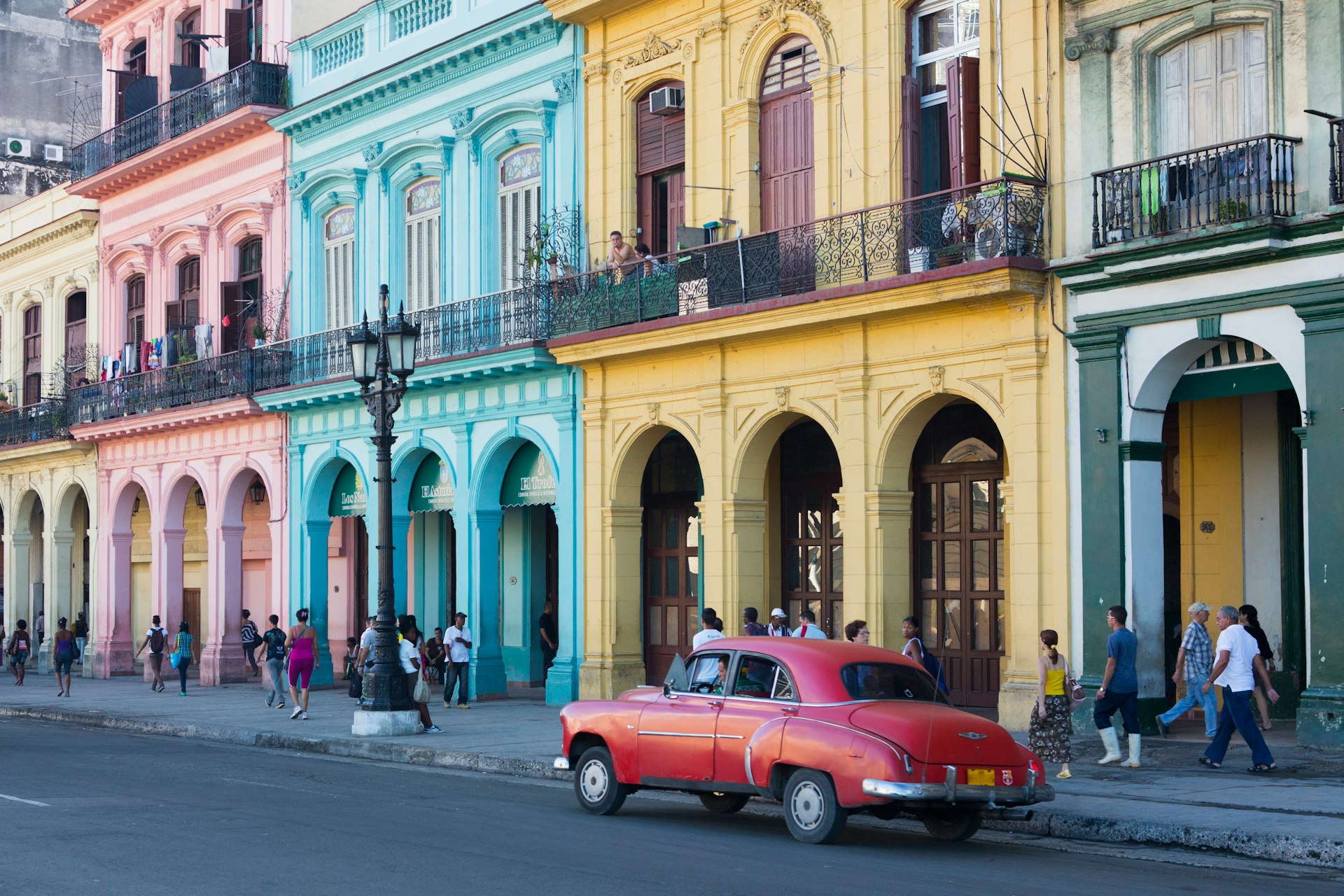
Is it safe to visit Cuba?
So far, Cuba has performed surprisingly well in both managing the pandemic and reopening for tourism in a way that is safe and effective. Six hotels were operating when I visited, but other tourist zones in Cayo Santa María and Varadero are due to open in early November.
All hotels are well staffed with a resident nurse, doctor, and epidemiologist, and fully stocked with abundant sanitizers and cleaning materials. Staff generally work two-week shifts followed by two weeks at home. They are tested before every new shift and always wear face masks when dealing with tourists.
While no system is fool-proof and COVID-19 has a nasty way of eking its way into anywhere and everywhere, Cuba’s reopening has proved to be unique and relatively low-risk. Two months in, only one person (a Cuban-American) has tested positive for coronavirus. If you’re longing for a quiet getaway and can handle the 14-day quarantine when you get home, keep an eye out as new travel bridges open and more airlines resume flights. In Cuba, you’ll be heartily welcomed.
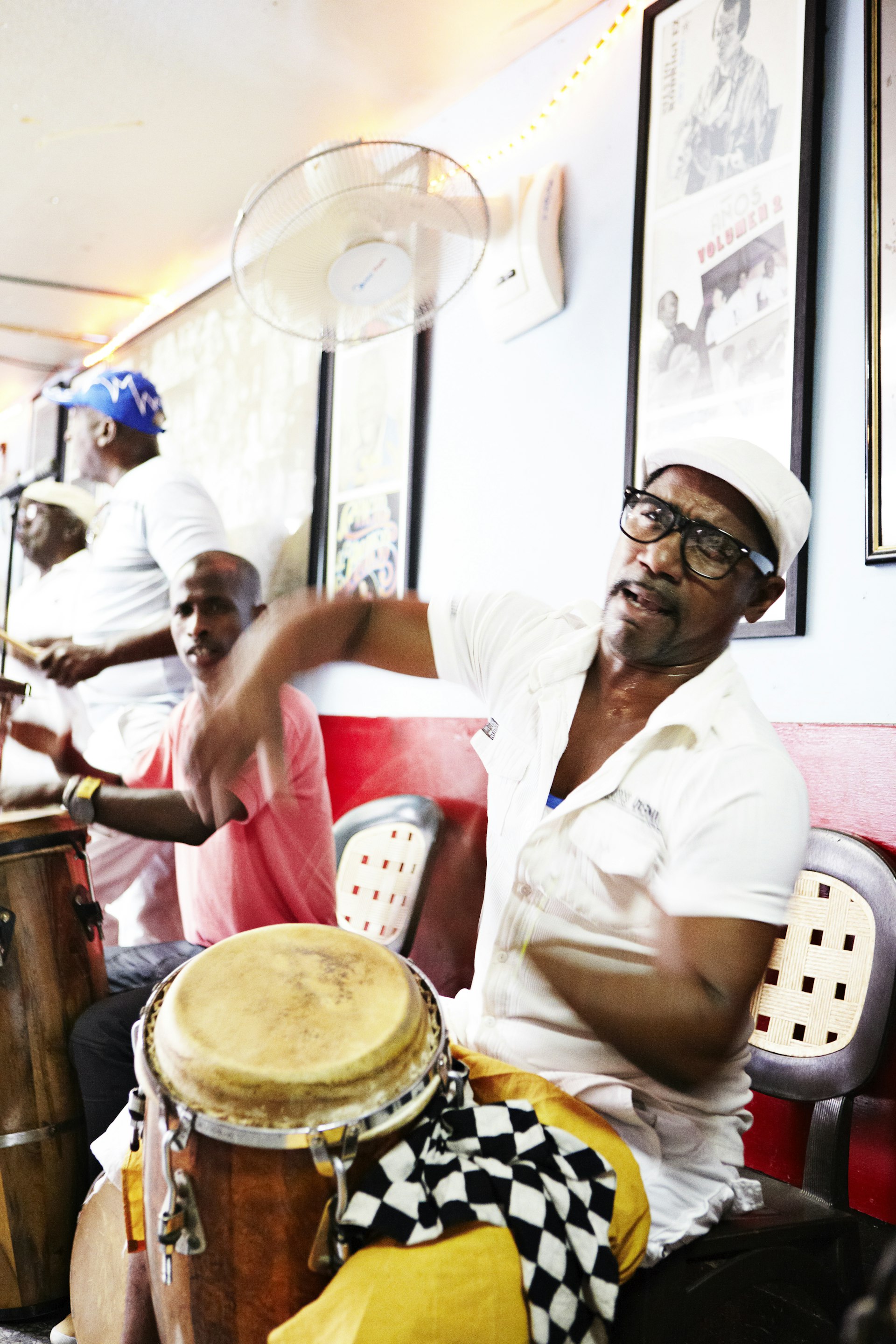
How to visit Cuba
TUI Group resumed twice-weekly flights from the UK to Cuba starting in the late October. Flights run from Manchester and London Gatwick to Varadero. Travelers must book full hotel packages and aren't allowed to leave the resort zone. Covid insurance is included in the package and all visitors get a free Covid test at Varadero airport. UK citizens aren't required to quarantine when they return home. German charter Condor will also resume flights to Varadero in early November from Frankfurt & Dusseldorf.
From Canada, Air Canada Vacations flies once a week from both Toronto and Montreal into Jardines del Rey Airport. Varadero flights will be added in November and Cayo Santa Maria in December. Westjet , Sunwing and Air Transat will resume flights from Canada to Cuba in early December.
Currently, there are no flights from Cuba to the US.
For the time-being, only three main tourist enclaves are open for business: Cayo Coco, Cayo Santa Maria and Varadero.
You can't currently fly into Havana and the city remains closed to international visitors. As yet, there is no concrete date for when the city will reopen (word on the street suggests before Christmas).
You might also like:
Here are the new rules for visiting the Caribbean Why female Cuban professionals are leaving their careers to become artists Which Caribbean island is best for you
Get more travel inspiration, tips and exclusive offers sent straight to your inbox with our weekly newsletter .
Explore related stories
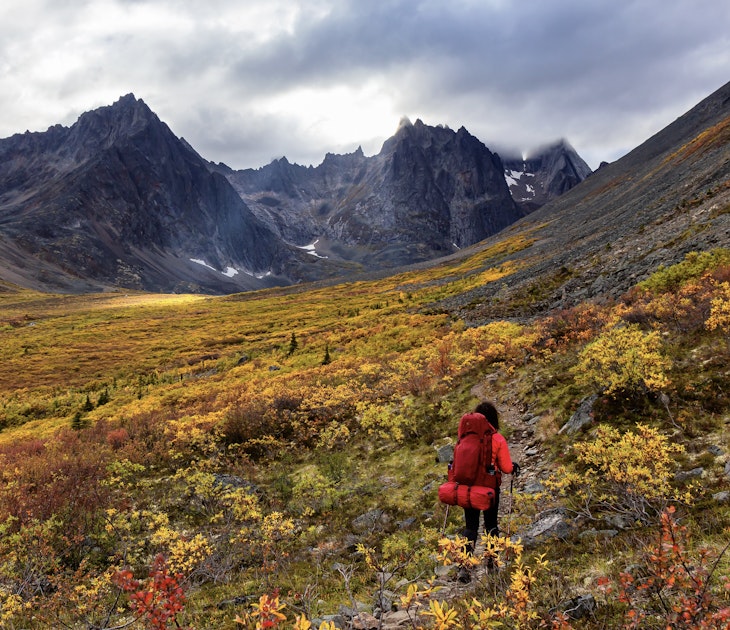
Apr 15, 2024 • 12 min read
The best way to take in Canada’s awe-inspiring landscapes? On your own two feet. Consider starting with these 16 hiking trails all over the country.

Apr 13, 2024 • 8 min read

Apr 12, 2024 • 7 min read

Apr 11, 2024 • 6 min read
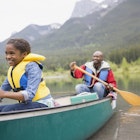
Apr 11, 2024 • 10 min read

Apr 2, 2024 • 8 min read

Mar 30, 2024 • 4 min read
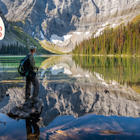
Mar 19, 2024 • 6 min read
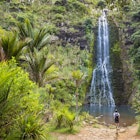
Mar 15, 2024 • 17 min read

Mar 1, 2024 • 12 min read
Stay up to date with notifications from The Independent
Notifications can be managed in browser preferences.
UK Edition Change
- UK Politics
- News Videos
- Paris 2024 Olympics
- Rugby Union
- Sport Videos
- John Rentoul
- Mary Dejevsky
- Andrew Grice
- Sean O’Grady
- Photography
- Theatre & Dance
- Culture Videos
- Food & Drink
- Health & Families
- Royal Family
- Electric Vehicles
- Car Insurance deals
- Lifestyle Videos
- UK Hotel Reviews
- News & Advice
- Simon Calder
- Australia & New Zealand
- South America
- C. America & Caribbean
- Middle East
- Politics Explained
- News Analysis
- Today’s Edition
- Home & Garden
- Broadband deals
- Fashion & Beauty
- Travel & Outdoors
- Sports & Fitness
- Sustainable Living
- Climate Videos
- Solar Panels
- Behind The Headlines
- On The Ground
- Decomplicated
- You Ask The Questions
- Binge Watch
- Travel Smart
- Watch on your TV
- Crosswords & Puzzles
- Most Commented
- Newsletters
- Ask Me Anything
- Virtual Events
- Betting Sites
- Online Casinos
- Wine Offers
Thank you for registering
Please refresh the page or navigate to another page on the site to be automatically logged in Please refresh your browser to be logged in
Cuba travel guide: Everything you need to know before you go
Many picture the faded pastel streets of vintage-feel havana, but beyond the capital there’s a wild side to cuba, plus more elegant old cities and dreamy beaches, article bookmarked.
Find your bookmarks in your Independent Premium section, under my profile
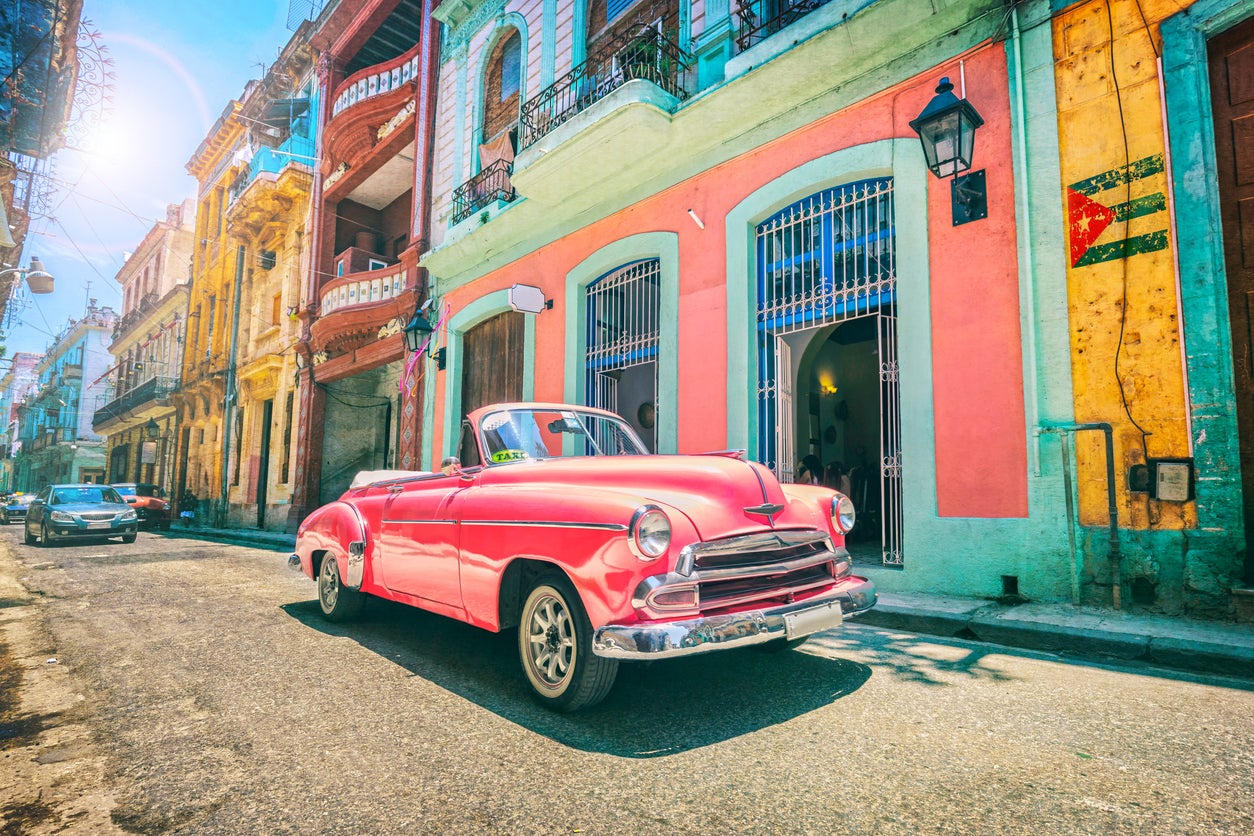
Sign up to Simon Calder’s free travel email for expert advice and money-saving discounts
Get simon calder’s travel email, thanks for signing up to the simon calder’s travel email.
Dazzling sugar-soft beaches, twinkling turquoise seas, palm-tree studded mountain trails, muscular castles, and pretty cities brimming with handsome villas, live bands, salsa dancing, and art. Oh, and those vintage, colourful American cars… Cuba is an enigma, clinging to socialism while finding its feet in a post-pandemic world. Come for vibrant Havana and its nightlife but take off into the wilds of this crocodile-shaped isle for adventure, wild beaches, cultural quirks, cigars, diving, festivals and foodie spots, and the best thing of all – the warm and witty Cubans.
Current travel restrictions and entry requirements
There are no Covid restrictions on entry or on the ground. Travellers must obtain a visa-like tourist card and fill out the online Viajeros form before travelling.
Best time to go
Cuba is a great destination year round, but is insufferably hot in July and August (though the city of Santiago de Cuba hosts two riotous, musical festivals in July that are worth catching). November to April is high season, when the weather is glorious, and prices are higher. Dozens of festivals and events are held in this period: music, dance, ballet, jazz, film, and art. Hurricane season runs from June until November.
Top regions and cities
The Spanish conquerors of Cuba grew rich on the back of the sugar and tobacco trade and poured their wealth into one of the finest cities in the Americas. As a result, Havana is gorgeous: richly worked with colonial villas, decorated churches, flower-filled patios, Art Deco towers, and 50s mansions. Find its heart in the streets of the Old City, now vibrant with indie shops, bars, and cafés. Stroll the ocean promenade, the Malecón, and hail a chrome-festooned vintage motor to tour the castles on the bay and the leafy streets of villas and galleries of the Vedado neighbourhood. By night, seek out rooftop bars, art gallery openings, and boho nightlife spots across the city.
- Read our Havana city guide
Viñales Valley
It’s impossible not to be seduced by this lush valley of mini mountains, royal palms, tobacco farms, horse-riding farmers, and cutesy B&Bs in rural Cuba. At dawn a mist encircles the columns and porches of homes in Viñales town. Breakfast on eggs and mango as the sun burns through, then venture out on a horse, or by foot, to explore this Jurassic region of Cuba where towering limestone humps, known as mogotes , dot the valley floor, a result of millions of years of erosion. At sundown sit on the porch of your B&B sipping a freshly made mojito. You’ll find delicious farm-to-fork food in Viñales, too.
On the southern coast of Cuba, the tiny, cobbled streets of Trinidad spill down the foothills of the Escambray Mountains towards the beautiful blue Caribbean Sea. Trinidad is a photographer’s and salsa dancer’s dream. Huge mansions, all cinnamon, avocado and ochre-hued and fitted with European marble and chandeliers, were built by sugar barons who reaped enormous wealth from the slaves who worked their record-busting sugar plantations. Today these ornate buildings are galleries, museums, restaurants, and private homes. Find some of the most ridiculously pretty B&Bs in the country here. Dance the night away to live music and recover on the nearby Caribbean beach the following day.
Santa Clara
Che Guevara, the Argentine doctor turned Cuban guerrilla, is buried in an elaborate mausoleum sculpture complex on Santa Clara’s Revolution Plaza. Alongside his mortal remains are those that died with him in a failed guerrilla campaign in Bolivia in 1967. Visit the neighbouring Che museum, too, before heading off to the Café-Museo Revolución where, alongside a strong cup of Cuban coffee you can soak up the café owner’s incredible Che memorabilia collection. Nightlife pivots around the theatre and bars of the main square but don’t miss the wonderful El Mejunje alfresco club famous for live music, cabaret, and LGBT nights.
Santiago de Cuba
With winding historic streets that climb from the enormous harbour up to the city centre, you’ll get a sense of the setting of the island’s second city. It’s surrounded by monumental mountains, one of them named after a famous cocktail. And it was in this fabled place, that Señor Bacardí discovered the secrets of ageing rum 160 years ago and launched the world’s most famous rum. Explore the homes, museums, and music spots of this lively city – more Caribbean in feel than distant Havana and soak up the live African and Spanish rooted music in town centre venues, daiquiris and mojitos in hand! Fidel Castro’s tomb is found at the city’s impressive marble cemetery.
Best under-the-radar destinations
Baracoa is Cuba’s best-kept secret. Six hundred miles from Havana, it’s a trek to get there, but oh so worth it. You’ll climb mountains, bathe in crystal-clear rivers, swing in hammocks, visit cacao farms, search for aboriginal hideouts, and taste some of the best food in Cuba – fish bathed in coconut, and a mashed coconut, honey, and nut dessert wrapped in a palm cone. Dance it all off in the little bars and Casa de la Trova (a local meeting house or dance hall) fringing the tiny main square.
Down on the south coast of Cuba – with one road in and one road out – is the Bay of Pigs, infamous for the US attempted invasion of the island in 1961. But it’s not just a site for history buffs: the water is the most beautiful in Cuba, aquamarine flecked with inky indigo blue, home to colourful fish, and the odd war wreck. Snorkel, dive, and bike to secret beaches along the jagged limestone coast here, backed by swamp peppered with Cuban crocs and colourful endemic birdlife.
Remote Gibara is a fishing port of white houses and jumbled rooves crammed around a small harbour in northeast Cuba. It bursts into life for the annual international cinema festival in August which attracts Cuban and international stars. Come for the caves that can be explored with guides, the tasty regional fare rooted in fish and shellfish, and a highlight – the chance to dive in a series of beautiful sinkholes scattered in pristine jungle settings around town.
Best things to do
Stay in a cuban b&b.
Few places in the world offer fancy digs for very fair prices. In Cuba you can bed down in villas, mansions, fincas (farmhouse stays) and Art Nouveau apartments for unthinkable prices. But, more than that, the Cuban families who host international guests will be the stars of your stay. The photos of fabulous interiors will get a zillion likes on the ‘gram, but the memories of your warm, loquacious hosts with 101 gripping stories to tell will linger longer.
Lonely mountain roads with epic scenery, isolated Spanish colonial towns and rural villages, virgin white sand beaches with not another soul in sight, and quirky attractions found away from tourist hotspots. All this is possible in a hire car, and more. You’ll need to reserve, and fuel costs are rising, but there’s no better way to explore off the beaten track especially as the public coach network is limited. Bring your own snorkel, and lunch!
Take a guided art tour
One of the extraordinary hallmarks of Cuba’s 1959 revolution was a huge investment in the arts. You’ll find world-class art in Cuba, Havana especially, and a guided tour to the homes and studios of some of the best artists at work on the island is a fascinating introduction to the fertile arts’ scene, and life in Cuba in general. Works from Cuba’s living artists are found in New York’s Metropolitan Museum of Art and MoMa, and London’s Tate. Choose your medium, or let the guide choose for you.
Getting around
Hiring a car isn’t cheap. Use the public coach company Víazul ( bookable online inside and outside the country) which runs regular buses from Viñales in the west to Baracoa in the east, with routes out to popular beach resorts and cities. New air-conditioned train carriages launched in 2019 but the network is antiquated. Train tickets can be bought at any Viajeros agency office on the island (cash purchase). Licensed and unlicensed taxis can be used to get to remote spots.
How to get there
TUI is the only airline flying direct from the UK to Cuba (Varadero beach resort) from Manchester. From London you can fly with Air France, Iberia, and Air Europa via other European cities, or with a couple of budget airlines including Spain’s World2Fly and Iberojet.
Money saving tip
Wifi is available at public wifi hotspots and accessible by scratch cards bought from telephone (Etecsa) offices or by resellers on the street. Buy a Cuban SIM card (which can be bought online before you fly) and pick it up at Havana’s international airport. A 30-day Turista SIM card costs US$25 and includes 6GB of data, 100 texts and 100 minutes of calls. Top-ups can be bought online .
What’s the weather like?
The weather is comfortably hot and breezy from November through to April. Daily tropical rains begin in May and run to October, but even these downpours evaporate in seconds. As mentioned above, July-August can get too stiflingly hot for many.
What time zone is it in?
Cuba is five hours behind GMT.
What currency do I need?
Cuba united its dual currencies in January 2021; the Cuban Peso (CUP) is now the sole official currency, but the monetary situation in Cuba is currently complicated - with locals using MLC (a currency which Cuban must upload to their bank cards by buying foreign currencies) for some purchases. This is an excellent overview.
For a holiday, bring plenty of Euros in cash (more than you think you’ll need) to pay for accommodation on the go, restaurant meals, and private transport and services. Bring a debit or credit card (with no connections to the United States; call your bank to check) to buy essentials such as bottled water, medicines, hygiene products and some food at “MLC” (Moneda Libremente Convertible) stores, where cash is not accepted. Bank cards are used to pay for car hire; the island’s only coach service, Víazul; activities such as diving, sailing trips and canopy walking; and accommodation and meals at government-owned hotels and restaurants, as well as to withdraw cash in Cuban Pesos (CUP). The CUP is used to buy street food, restaurant meals, museum entrances, local transport, and train transport. Change a small amount of Euros into CUP on arrival. Black market rates for your Euros will make your holiday much cheaper.
What language is spoken?
Spanish is the official language.
Anything else I should know?
Cuba is a communist, one-party state. Do read up on the politics and economics before you visit. Bring all medications you may need with you.
Join our commenting forum
Join thought-provoking conversations, follow other Independent readers and see their replies
Subscribe to Independent Premium to bookmark this article
Want to bookmark your favourite articles and stories to read or reference later? Start your Independent Premium subscription today.
New to The Independent?
Or if you would prefer:
Want an ad-free experience?
Hi {{indy.fullName}}
- My Independent Premium
- Account details
- Help centre

- Pinar del Río
- Las Terrazas
- Centro Habana
- Villa Clara
- Santa Clara
- Cayo Santa María
- Sancti Spíritus
- Ciego de Ávila
- Cayo Guillermo
- Jardines del Rey
- Santiago de Cuba
- Isla de la Juventud
- How to Get Here
- Means of transportation
- Trips to Cuba
- Natural Reserves and Parks
- Theme parks
- Zoos and Aquariums
- Surf and Kitesurf
- Travel Packages
- New Year’s Eve
- All-Inclusive Trips
- End-of-college trip
- Events and Congresses
- Other Cities
- Havana Airport
- Varadero Airport
- Cayo Santa María
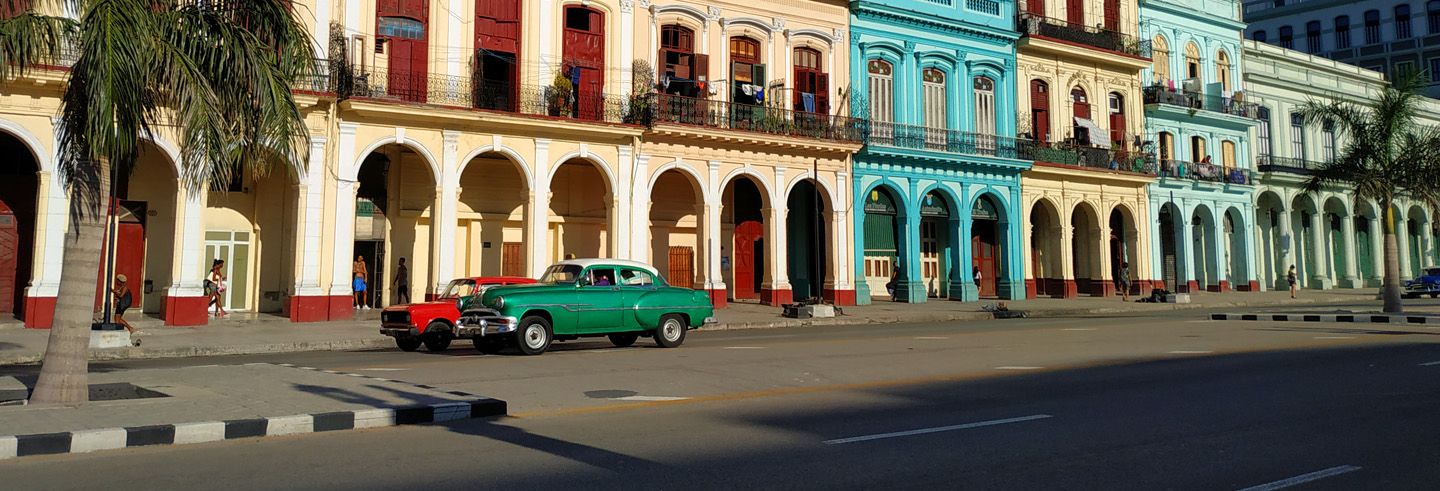
Organization of Cuban agencies

- Organized Trips
- Taxi / Transfer
- Casas Particulares
- All-Inclusive trips
- Agencies / Tour Operators
Cuba in July
Are you planning to travel to cuba in july do it with the guarantee of an expert cuban agency and enjoy a truly unique experience.
Enjoy your trip to Cuba in July with the peace of mind of having an organization of specialized Cuban agencies , with offices around the world. Fill in the following form so that we can better understand your preferences and one of our experts will start preparing a personalized proposal in detail . We strive to make your dream trip come true at an ideal cost.
Request your Budget Now:
Data about your trip:
What stage are you at in planning your trip?
Are you travelling with children?
Have you decided the dates of your journey?
Return date:
Would you like to book your flights?
Yes: No: Departure airport or city:
Would you like to book your accommodation?
Which accommodation category do you prefer? Homes where to experience the local way of life 3 or 4 star hotels Luxury hotels All-inclusive hotels
Would you like to contract any of these services?
Private transfers Car rental Tourist guide
Budget: $USD per person (Not including the flights)
Attention: The minimum budget we can offer you for 7 days is 450 $USD.
Tell us more about your trip:
Personal and contact data:
Phone number:
Country of residence: Afganistán Albania Alemania Andorra Angola Anguilla Antártida Antigua y Barbuda Antillas Holandesas Arabia Saudí Argelia Argentina Armenia Aruba Australia Austria Azerbaiyán Bahamas Bahrein Bangladesh Barbados Bélgica Belice Benin Bermudas Bielorrusia Birmania Bolivia Bosnia y Herzegovina Botswana Brasil Brunei Bulgaria Burkina Faso Burundi Bután Cabo Verde Camboya Camerún Canadá Chad Chile China Chipre Ciudad del Vaticano (Santa Sede) Colombia Comores Congo Congo, República Democrática del Corea Corea del Norte Costa de Marfíl Costa Rica Croacia (Hrvatska) Cuba Dinamarca Djibouti Dominica Ecuador Egipto El Salvador Emiratos Árabes Unidos Eritrea Eslovenia España Estados Unidos Estonia Etiopía Fiji Filipinas Finlandia Francia Gabón Gambia Georgia Ghana Gibraltar Granada Grecia Groenlandia Guadalupe Guam Guatemala Guayana Guayana Francesa Guinea Guinea Ecuatorial Guinea-Bissau Haití Honduras Hungría India Indonesia Irak Irán Irlanda Isla Bouvet Isla de Christmas Islandia Islas Caimán Islas Cook Islas de Cocos o Keeling Islas Faroe Islas Heard y McDonald Islas Malvinas Islas Marianas del Norte Islas Marshall Islas menores de Estados Unidos Islas Palau Islas Salomón Islas Svalbard y Jan Mayen Islas Tokelau Islas Turks y Caicos Islas Vírgenes (EEUU) Islas Vírgenes (Reino Unido) Islas Wallis y Futuna Israel Italia Jamaica Japón Jordania Kazajistán Kenia Kirguizistán Kiribati Kuwait Laos Lesotho Letonia Líbano Liberia Libia Liechtenstein Lituania Luxemburgo Macedonia, Ex-República Yugoslava de Madagascar Malasia Malawi Maldivas Malí Malta Marruecos Martinica Mauricio Mauritania Mayotte México Micronesia Moldavia Mónaco Mongolia Montserrat Mozambique Namibia Nauru Nepal Nicaragua Níger Nigeria Niue Norfolk Noruega Nueva Caledonia Nueva Zelanda Omán Países Bajos Panamá Papúa Nueva Guinea Paquistán Paraguay Perú Pitcairn Polinesia Francesa Polonia Portugal Puerto Rico Qatar Reino Unido República Centroafricana República Checa República de Sudáfrica República Dominicana República Eslovaca Reunión Ruanda Rumania Rusia Sahara Occidental Saint Kitts y Nevis Samoa Samoa Americana San Marino San Vicente y Granadinas Santa Helena Santa Lucía Santo Tomé y Príncipe Senegal Seychelles Sierra Leona Singapur Siria Somalia Sri Lanka St Pierre y Miquelon Suazilandia Sudán Suecia Suiza Surinam Tailandia Taiwán Tanzania Tayikistán Territorios franceses del Sur Timor Oriental Togo Tonga Trinidad y Tobago Túnez Turkmenistán Turquía Tuvalu Ucrania Uganda Uruguay Uzbekistán Vanuatu Venezuela Vietnam Yemen Yugoslavia Zambia Zimbabue
I agree with the Privacy Policy and the data processing
What is there to see in Cuba in July?
What is there to do in cuba in july, how is the weather like in cuba in july.
- Why trust our team of specialists?
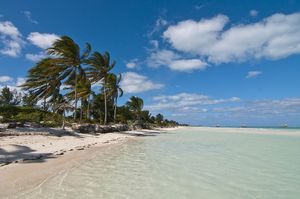
Fill your vacation with tropical essence by traveling to Cuba in July, visiting the most important and emblematic places, places full of charm, and refreshing yourself on the most spectacular beaches in the Caribbean. Our experience and knowledge of the destination allows us to recommend all the places you must see so that you make the most of your visit.
The history of Cuba is reflected in many places that were protagonists in the changes that the country went through with time, such as the historic center of Havana known as La Habana Vieja ( Old Havana ), the wide and long Havana Malecón with its beautiful view of the Cuban coast. Or, simply meet the ever-cheerful Cubans who spread their flavor to all tourists.
Trinidad is also a city with a lot of history, which you can see in its high-level architectural heritage, a symbol of the economic boom of the sugar industry in the area. Today it is considered the museum city of Cuba, so do not hesitate to visit and walk through its cobbled streets.
The cities Cienfuegos and Camagüey , declared by UNESCO as a World Heritage Site , like Trinidad , are other cities that you must visit. The first has an important French influence in its streets and traditions, and, on the other hand, the second offers you labyrinthine streets that will make you lose yourself among so much history that its corners carry.
Santiago de Cuba , in the southeast of the island, having been the capital of the country in ancient times, treasures places that were witnesses of the first colonies and gave rise to this nation. Baracoa is another destination where you should get lost, contemplating the beauty of its colonial architecture contained by mountain ranges and its beautiful beaches. The cultural richness is mixed with people with a charming accent that will add warmth and joy to your days, making you always feel at home.
Undoubtedly one of the main attractions is its beautiful beaches, where the turquoise of the sea merges on the horizon with the blue of the sky, enveloping you in an amazing panorama. Varadero is the seaside resort par excellence and the most famous, but you have many more offers to enjoy kilometers of beaches such as the Jardines del Rey . There you can enjoy Cayo Coco, Cayo Guillermo and Cayo Santa María . In addition to enjoying the sun and relaxing in its warm waters, you can dive and snorkel , thus venturing into the depths to observe the incredible coral barriers and various species that populate the seabed. Cayo Largo del Sur is another place that you have to see. Its kilometers of beaches, many of them still virgin beaches, will make you hallucinate with their beautiful landscapes in the middle of the Caribbean Sea .
In this charming country, the rhythm is not only marked by the music so characteristic of Cuba, but also by the sounds of nature. You can listen to them in Topes de Collantes, immersed in the Sierra del Escambray. Its incredible microclimate, with lower temperatures than the rest of the island and moderate humidity, make it a perfect place for hiking enthusiasts, where they can walk through lush nature to reach incredible waterfalls and waterfalls.
In the Sierra Maestra, you can walk through the highest peaks in the entire country, such as the Pico Turquin o located in the heart of the mountain range, which borders 2,000 meters above sea level . Another important attraction is the Gran Piedra ( Great Stone ), a beautiful rock weighing more than 70,000 tons and is used as a natural viewpoint to observe the wonderful panoramic views that this incredible place offers you, surrounded by trees and nature.
Las Terrazas, in the province of Artemisa , is an ecological village dealing with tourism and sustainable development.You will be able to stroll along the Río San Juan (San Juan River) in rowing boats, walk along incredible trails and, above all, jump through the canopy inserted in the middle of the forest and observe the incredible landscape that surrounds you. Very close to Las Terrazas is the town of Soroa , where you can see the Orquideario de Soroa ( Soria Orchidary ), one of the largest in the world with more than 25,000 species distributed in the beautiful gardens of the place. Without a doubt, it is an activity you should do on your trip to Cuba.
To coincide with the residents' summer vacations, several typical events of cultural interest are held, such as Cuban carnivals, among other important dates for locals, which are part of the offer of activities for tourists to do . July is the ideal season to get to know Cuba and its culture from the inside, in addition to enjoying the attractions of the cities and beaches.
The first week of July, in Santiago de Cuba, the La Fiesta del Fuego ( Fire Festival ), also known as the Festival del Caribe ( Caribbean Festival ) , takes place. It lasts several days, where the people and dancers go out to dance to the rhythm of local musical groups that play drums, trumpets and other instruments, producing melodies that the body cannot ignore. It is a true festival that exposes the origins of this culture through the expression of the original tribes, their colors, rhythms and dances, filling the city with bustle, joy and color, with thousands of tourists who dare to participate and let themselves be carried away by the rhythm. On the last day, the figure of a great devil is set on fire, representing everything negative, to remove the bad, leaving room for new and good things.
The party continues in Santiago de Cuba and also in Havana, with the arrival of the Cuban carnivals , one of the most important events of the year that the entire country awaits. Large floats full of color animate the public as they go through the main arteries of each city. People participating in the parade in flashy costumes move to the beat of the music, encouraging the spectators who respond with joy. These are days that are lived with great happiness, where people of all ages get together to have a good time, sharing dances, drinks and lots of fun.
July 26 is the Día de la Rebeldía Nacional ( Day of National Rebellion ), in memory of the assault on the Moncada Barracks , in which a group of militants led by Fidel Castro tried to overthrow the de facto government of Fulgencio Batista . Although it did not triumph, it marked the beginning of a series of confrontations that sought the freedom of the people, leading to the Cuban Revolution . These events are commemorated with three days decreed as national holidays, July 25, 26 and 27. Massive acts are usually carried out with speeches in honor of those struggles and subsequent triumph, with musical shows by local artists , where hundreds of Cuban flags are raised to claim the homeland. It is a very special time in which you can see the Cuban patriotic fervor in all its splendor.
With a tropical climate characterizing it, if you travel to Cuba in July you will find very pleasant warm weather, characteristic of summer. Temperatures are between 23 and 31 degrees, and the days are characterized by being very sunny despite the brief rains t hat usually occur regularly, so you should not worry about them. The temperature of the sea water is warm and bathing in it will be one of the most pleasant things you can do on your visit to this country. July is an ideal month to get to know Cuba in summer and cool off on its spectacular beaches. You should wear light clothing that allows you to walk comfortably and coolly when going on excursions, and a pilot or light coat that can protect you in case a rain surprises you. It is also recommended that you bring garments to protect from the sun such as a cap or hat, high factor sunscreen and sunglasses to avoid any hot flashes that interfere with the enjoyment of your Cuban vacation.
Reasons to trust our team of professionals
We are an organization of Cuban agencies specialized in organized trips to Cuba, with an international presence , where you will receive the help and information necessary to program your desired trip or event. Further:
- • We support the local economy by joining forces with Cuban entities to provide wonderful 100% native experiences. • We organize personalized trips and events thanks to our experts specialized in Cuban tourism. • We offer reservations for accommodation in private homes and hotels, transfers, guides, excursions and car rentals (cars) 100% guaranteed. • You will have 24-hour assistance in Cuba every day of the year to face any eventuality or modification that you wish to make. • We work with a secure and guaranteed payment platform for your peace of mind. • We will take care of all the formalities before and during the trip: compulsory insurance, tickets, visas (visa), even any extra reservation you want to make at any time. • All our agencies are committed to responsible and sustainable tourism , both environmentally and socially .
Why "Trip Cuba"?
Trip Cuba is an organization of Cuban agencies whose objectives are:
- ✓ To make Cuba , its culture and its heritage known .
- ✓ To promote sustainable tourism .
- ✓ To support the local economy, prioritizing direct contact with Cuban agencies .
Travel Agencies
If you are a travel agency or tour operator and you are looking forward to any assistance or collaboration to plan trips to Cuba , rely on our extensive experience

Beyond the Ban: A Guide to Americans Visiting Cuba in 2024.
If you are a US citizen, you can still visit Cuba in 2024. However, unlike your neighbors traveling from Canada , you will be subject to specific regulations from the US government.
For example, doing “tourism,” like staying at a resort on a Cuban beach , isn’t allowed. Your trip must fall into one of 12 categories of authorized travel to Cuba. You must also comply with certain financial restrictions while on the island.
This article offers our first-hand experience organizing trips from the US to Cuba for over seven years. We will answer all your questions about going to Cuba as an American, including the entry requirements, the 12 categories of authorized travel, People-to-People travel, the Support for the Cuban People license, and much more.
In this guide, we cover all of it.
Can Americans Travel to Cuba in 2024?
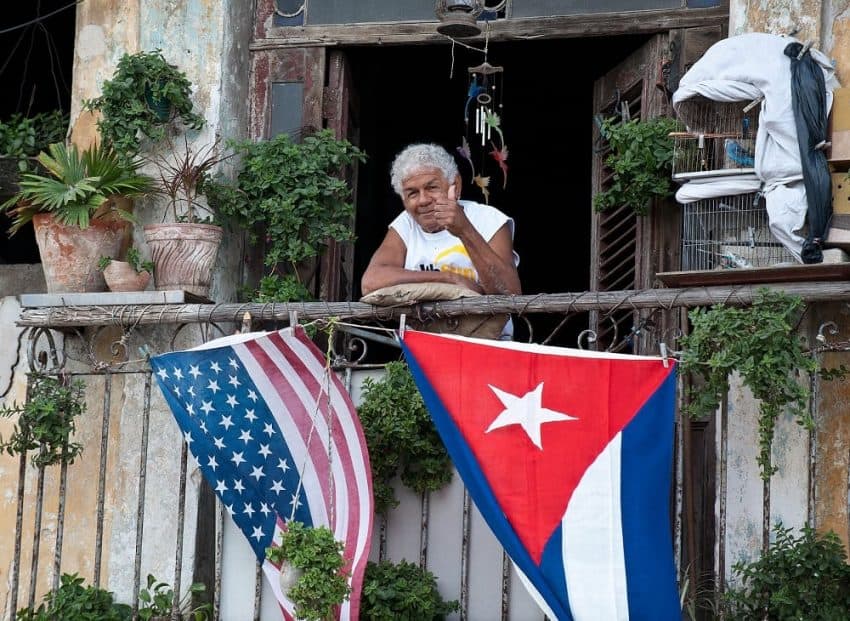
The simple answer is yes. It’s perfectly legal for Americans to travel to Cuba, except for explicit tourism purposes.
Americans can’t go to Cuba for tourism thanks to the Cuban Assets Control Regulations of July 8, 1963, which imposed a trade embargo on the island.
However, you can travel legally to Cuba if you comply with certain Cuban and US government regulations.
Specifically, the Cuban government asks you to bring the following documentation:
- The Cuban Tourist Card (a.k.a Cuban Visa).
- Health travel insurance.
- Customs and health declaration forms.
On the other hand, the US government requires you to:
- Self-certify under one of the 12 travel categories of authorized travel to Cuba
- Avoid spending money at certain restricted businesses.
- Keep your travel receipts and records for five years.
Does that sound like a lot? In the sections below, we explain how to meet these requirements so you can travel legally to Cuba from the US.
The Cuban Tourist Card
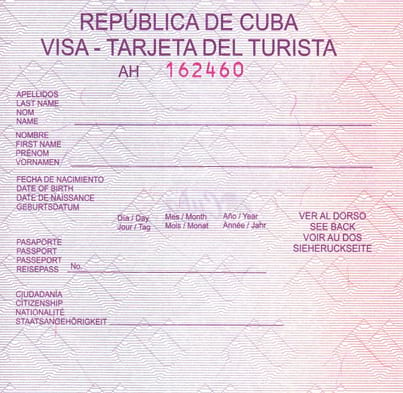
The Cuban Tourist Card is a tourist visa that almost everyone traveling to Cuba for tourism must bring. They come in two colors: pink and green.
In most cases, US citizens must get the pink Cuban Tourist Card because they fly directly from a US airport to Cuba. However, if you plan on leaving from a non-US airport, you will need the green version.
In any case, we suggest you purchase the Cuban Tourist Card through your airline or on EasyTouristCard.com .
Buy it From Your Airline
The cost of the Cuban tourist visa is usually bundled into the ticket price. However, in some cases, you will need to purchase the visa separately. Prices range from 50 to 80 US dollars, depending on the airline.
Please note that only a few US airlines fly to Cuba. Check out Skyscanner to find all available flights from the US to Cuba.
Purchase it on EasyTouristCard.com
If you can’t get the Cuban Tourist Card through your airline, the best alternative is to purchase it online from Easy Tourist Card , a widely trusted provider.
The pink version costs about 100 US dollars, while the green version sells for roughly 35 US dollars.
Mandatory Travel Health Insurance
Travel health insurance is an entry requirement to Cuba.
Your policy must cover emergency medical treatment, hospitalization, and repatriation. The Cuban government won’t allow you to leave the country with outstanding medical bills!
Based on our assessment of the most popular travel health insurance providers for Cuba , we recommend Insubuy .
On Insubuy , coverage for medical emergencies, hospitalization, and repatriation starts at 8 USD per week per person and is pretty comprehensive.
Customs and Health Declaration Forms
Cuba requires all travelers to bring a Sanitary Statement and a Customs Declaration form.
You can complete the documentation at D’Viajeros , the government’s website. It will save you time and annoyance at the Havana Airport !
The 12 Categories of Authorized Travel to Cuba
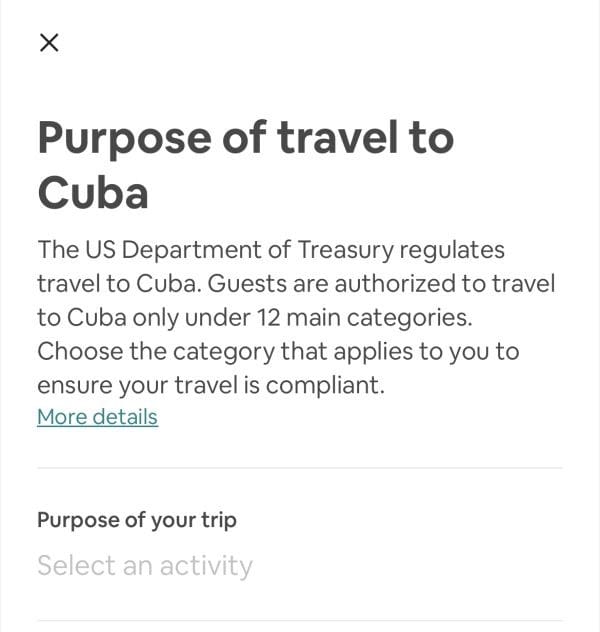
A “category of authorized travel to Cuba” is also known as a “travel license” or “general license.”
Confusingly, even though it’s called a license, it is not a physical or digital document. It’s a self-certification you need to do when travel providers, such as airlines and hotels, ask you about it. In most cases, it’s just about ticking a box.
Obviously, before you tick that box, you should review whether you meet the criteria for traveling to Cuba under your chosen category.
There are 12 categories of authorized travel to Cuba , as defined by the Office of Foreign Assets Control (OFAC):
- Family visits
- Official business for the US government, foreign government, and certain intergovernmental organizations
- Professional research and professional meetings
- Educational activities
- Religious activities
- Public performances, clinics, workshops, athletic and other competitions, and exhibitions
- Support for the Cuban People
- Exportation, importation or transmission of information or informational materials
- Humanitarian projects
- Activities of private foundations or research or educational institutes
- Certain export transactions
In 90% of the cases, a US citizen will travel to Cuba under either the Education Activities or the Support for the Cuban People categories.
Educational Activities (People-to-People Travel)
People-to-people travel falls under the Educational Activities category. This license aims to promote people-to-people contact, support civil society in Cuba, and encourage the Cuban people’s independence from Cuban authorities.
You can travel under this license provided that your trip is:
- Organized by a US travel company (the “sponsoring organization”).
- Escorted by an employee of the sponsoring organization.
People-to-people travel is the best option for Americans who want to go in a group and prefer to avoid the hassle of planning an itinerary in compliance with the US-Cuba travel regulations.
However, not everyone likes the crowds or having a chaperone around. Besides, traveling to Cuba independently is still legal, easy, and safe . For those, there is the Support for the Cuban People category.
The Support for the Cuban People Travel Category
The Support for the Cuban People category intends to promote US travel to Cuba to strengthen civil society on the island. It covers activities that:
- Foster closer connections with the Cuban people,
- Contribute to the development of Cuban civil society, or
- Advocate for the independence of the Cuban people from the government; and
- Involve meaningful engagement and interaction with individuals in Cuba.
American travelers love this category because it’s pretty vague. You have lots of wiggle room and can pretty much do many of the activities you would in any other country.
Here are examples of activities that can “strengthen Cuban society”:
- Visiting museums and historical sites.
- Eating at locally-owned restaurants (paladares).
- Taking Cuban cooking classes.
- Taking salsa dancing lessons.
- Touring a tobacco farm and learning how to roll Cuban cigars.
- Taking a tour through the best of Havana .
- Volunteering with a local organization or non-profit.
How does it sound?
However, we must remind you that you still can’t do tourism in Cuba under the Support for the Cuban People license. In fact, you should spend about 6-8 hours on a schedule of activities actually supporting the Cuban people.
That said, it’s not like an American official will call you daily to verify your schedule, so don’t stress too much about it.
You can also support the Cuban people in less subtle ways by:
- Bringing inexpensive items as gifts for locals . Most essential products you take for granted (toiletries, hygiene products, etc.) are hard to come by in Cuba. Bringing a thoughtful gift will show your appreciation and may meet your hosts’ vital needs.
- Tipping . The base wage for workers in Cuba is the equivalent of a few US dollars a month. Therefore, locals expect and highly appreciate tipping.
Finally, considering that the Internet is limited in Cuba , you should arrange your activities before you land on the island.
Restricted Businesses and Accommodations
The US Treasury Department doesn’t like Americans spending money anywhere in Cuba.
The Treasury keeps a list of businesses to which Americans must refrain from giving money. Most of these businesses are owned by the Cuban military or security services, with which the US still has a frosty relationship. You can see the full, updated list here .
The US government also forbids Americans from staying at specific accommodations listed in the Cuba Prohibited Accommodations List .
To be safe, we recommend renting a room from Cuban Airbnbs , also known as “casas particulares.” These privately owned and highly affordable accommodations can provide you with an authentic Cuban experience.
Check out Skyscanner for the latest listings of “casas particulares” and hotels in Cuba.
Travel Receipts and Records for Five Years
The US government can ask you for your travel records and receipts for up to five years after your Cuba trip.
This sounds spooky, although anecdotally, it doesn’t happen very often. But it’s better to be safe than sorry, so keep your records safe for five years if you’re questioned about your trip.
Bonus Tip for Americans Traveling to Cuba: Stick to Private
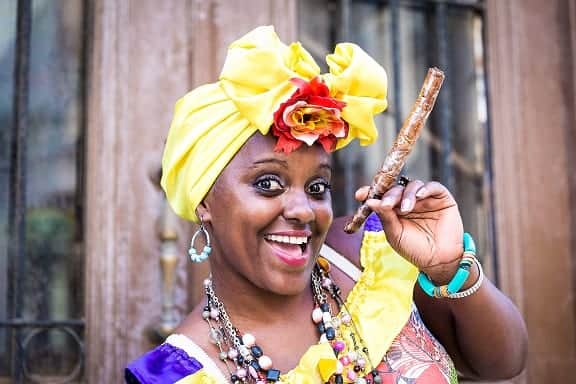
Generally, you should purchase most travel services and products from Cuban private businesses.
We know you can’t always stick to this principle because the Cuban government owns most of the travel facilities and services on the island, including hotels, car rental companies , tour agencies, and souvenir shops.
But whenever you can support Cuban entrepreneurs, please do so. You will strengthen the legality of your trip and genuinely help Cuban society.
Besides, if you want to cut your trip to Cuba costs , purchasing from locals will get you more bang for your buck. Not only is it more affordable, but you will likely pay in Cuban currency , the Cuban Peso, which is hugely devalued compared to the US dollar.
This includes:
- Booking tours from local guides .
- Staying in “casas particulares.”
- Eating at “paladares” (check out our food safety guide for Cuba ).
- Riding in private taxis, including “almendrones,” Cuba’s old classic cars .
- Buying souvenirs directly from local sellers.
For more tips and tricks you can pull in your trip to the island, read our 58 travel tips for Cuba .
US Legal Travel to Cuba, Summarized
If you are an American traveling to Cuba, you can break down the process into five relatively simple steps:
- Choose the best travel category to Cuba based on your travel purpose. If you are going in a group, it will likely be Educational Activities (People-to-People travel) or Support for the Cuban People if you travel independently.
- Ensure your itinerary has a full schedule of activities covered by your chosen travel category.
- Avoid booking an accommodation included in the Cuba Prohibited Accommodations List .
- Do not spend money on the specific prohibited businesses in Cuba .
- Keep your records and receipts for five years.
Once you overcome the legal (but easy!) challenges of traveling to Cuba, you will see that the effort was well worth it. If you feel ready but don’t know when, check out our guide to the best time to travel to Cuba .
Have you traveled to Cuba as a US citizen? We want to hear from you. Please share your experience in the comments below!
Essential Travel Logistics For Cuba
Cuban Tourist Card – If your Cuban Tourist Card (a.k.a Cuban Tourist Visa) isn’t bundled into your airline ticket or travel package, buy it only through EasyTouristCard .
Travel Health Insurance – Travel medical insurance is an entry requirement for Cuba, so you can’t skip it. Travelers can get travel health insurance for Cuba via Insubuy . Travel protection benefits such as trip interruption and cancellation, baggage delay insurance, etc., are not required.
Essential Items to Pack – Bring the essential travel necessities that you may not be able to get in Cuba:
- First aid kit
- Hand sanitizer
- Water bottle with filter
- Mosquito repellent
- Pin adapter (for Europeans)
- Travel guide
- Spanish-English phrasebook
- Suggested Reading: The Cubans: Ordinary Lives in Extraordinary Times
Read our complete packing list for Cuba .
Find Accommodations – Find hotels or casas particulares (private accommodations) on Skyscanner , which lists thousands of accommodations available in Cuba.
Book Your Flight – Book cheap flights to Cuba on Skyscanner , our favorite flight search engine to find deals on flights to Cuba.
Share Article:
About the Author
Tour republic.
Tour Republic is a marketplace where you can discover, book, and review the very best experiences Cuba has to offer. We are a team of tourism professionals and journalists who have partnered with Cuban entrepreneurs to provide travel experiences that can transform your trip into a life-changing adventure. We also share our profound love for Cuba through in-depth travel guides, myth-busting articles, and captivating narratives. Whether you want to explore Cuba's wonders or understand its intricacies, our blog posts are your gateway to the heart of this extraordinary country.
Leave a Reply Cancel reply
64 comments.
Assuming we meet all the other qualifications, is there no way for an American to go a beach in Cuba?
Hi Kat, Unfortunately, Americans are not allowed to simply go to the beach. I also don’t see going to the beach as an activity covered by any of the 12 travel categories. Honestly, if you go to the beach, it is unlikely that you will be fined since it’s hard for an US official to know that you did. However, it is not permitted.
Hola, queria saber si mi novia con ciudadania estadounidense y salvadoreña tiene que pedir algun tipo de visado especial ? Yo soy cubano con pasaporte cubano aun vigente.
Hi we booked our tour package from Canada, flight plus stay at the resort. I understand that my husband (Canadian citizenship) won’t have any problems, but for me (US Citizenship, Canadian resident) do I need to book separately a casa particulares to get into the country? And when i get in there, can I stay with my husband at the resort?
Hi juju, According to the regulations, you shouldn’t. First, you need to make sure that the resort is not on the restricted list . Secondly, keep in mind that Americans are not allowed to go to Cuba only for tourism purposes. Therefore, you should have an schedule of activities that fall under any of the 12 general licenses to travel to Cuba, as explained in the article.
The question: “Do you need a password to Cuba?” Should be: Do you need a PASSPORT to Cuba?
Fixed. Thanks a lot!
Thank you for the great information , very helpful . As an European flying from Miami to Havana with a valid ESTA visa could I enter back the USA with on the same Esta visa . Not easy to get as answer on the official us pages . Thanks .
It appears that you will need to apply for a visa to re-enter the United States. Read more here .
I tried to buy the pink visa on easy tourist but almost at the end my country is not on the list. Puerto Rico is part of USA but can’t complete the order. They wrote me but do not get the problem of the country. Where else can I buy online?
Hi, I’m Italian and I would like to travel to Cuba via Miami, but it seems the nationality doesn’t matter because we need to declare a specific category. But what if I just need to go to Cuba from USA with a one-way flight and I will come back home directly from Cuba to Europe?
How did it go? Where you able to do the trip as mentioned?
I am an adult I was born in the US. Lived here my whole life.
My mom and dad were born in cuba, came to America in the 90s, and got their citizenship over 8 years ago.
I believe for my parents to travel to cuba they may need a Cuban passport because I read that cuba does not recognize them as American, just Cuban.
However, I also read that because both of my parents were born there, I am the daughter and I too am a Cuban citizenship under Cuban law
I’ve read that a few times in a few pages and I wanted to know if it was true. And if I would need to get a Cuban passport myself
Please let me know! Thanks .,
Hi Aileen, If you were born in the US, you don’t need a Cuban passport to enter the country.
In your article, when quoting OFAC, the text “during his or her four-day trip” was included. Are visits to Cuba limited to four days?
I am a professional orchestral and choral conductor and composer, and my associate is a full-time jazz pianist and composer. We want to visit Havana to listen to Cuban salsa, jazz, etc, and to engage in one to one conversations with Cuban musicians—and maybe even join in playing, if invited! Six to eight hours per day would hardly be enough for us: we’d start at 17:00 and leave when everybody goes home—and that’s just the evening. Which category would you recommend for us? EXCELLENT website! Thanks so much!
kayak wont quote flights to me as of today siting regulatory issues…. has something changed?
Hi Danial, That’s correct. It appears that Kayak is not quoting flights to Cuba currently. I suggest you use Skyscanner instead.
So to be clear. We still can’t bring back any alcohol or tobacco from Cuba back into the US? I read in this article that there Is now no value restrictions like there used to be.. Can you advise please?
Hi Mark, No, legally, you cannot bring Cuban tobacco or alcohol to the US.
Ummmm damn I guess I’m the only one with this problem. Can felons go? Not on parole and the case is over and done but I know some counties trip and some don’t. So what’s cubas stance on it?
Hi Mike, According to Felony Record Hub , felons can enter Cuba as long as they don’t have an outstanding felony warrant or are not on a no-fly TSA list. Hope it helps!
Hey great information!! Thank you
When you say you have to declare your license(which mine would fall under the 12) during booking, what does that mean? How do you declare it?
Hi Orlando, Usually, travel providers will provide you with a form where you have to select the license you are using traveling to Cuba. You don’t have to get an “actual” license. That’s it 🙂 The only licenses that do require a physical license from OFAC are: – Professional research and professional meetings. – Public performances, clinics, workshops, athletic and other competitions, and exhibitions.
Hello! This is a great article. I am a US citizen considering sailing my boat from the Dominican Republic to Cuba and then on to Belize. Some of our crew (US citizens as well) may fly directly back to the US from Cuba. Is this plan legal and possible? Will the Cuban authorities have a problem with this plan? Will the US authorities have a problem with it once we return?
Hi Christopher,
Did you ever find out if you can go to Cuba by private boat?
Thanks, Sarah
My fiancée from Ukraine suggested we take a winter trip to Cuba. Since she is booking through a Ukrainian travel agency our stay and flight – is it okay to stay as her guest at a prohibited resort and when would I declare my travel intent/licensing? We would otherwise try to use up 6-8 hours per day supporting the local economy.
Hi Gerald, Usually, travel service providers (airlines, travel agencies, booking sites, etc.) ask you to declare your travel category while booking the trip, not after. I’m not sure at what point the Ukrainian travel agency would ask you about it or if they will do it at all. Unfortunately, if you are a US citizen, you shouldn’t stay at a prohibited accommodation in Cuba, regardless of where you are flying from.
my concern is nobody writes how long does it take to get permit to travel there, on one of our government pages it says up to 6 months ??
Hi there, You don’t need to apply for an actual license unless you are traveling under any of these two categories: – Professional research and professional meetings – Public performances, clinics, workshops, athletic and other competitions, and exhibitions.
I just found this concerning my question on banks in Cuba from US government site. Wonder what the alternative/s is to have funds in Cuba?
U.S. credit and debit cards do not work in Cuba. The Cuban Central Bank announced new restrictions on the use or conversion of U.S. dollars beginning June 21, 2021. U.S. dollars in cash cannot be converted to local currency, may not be accepted for payment, and cannot be used to pay fees or taxes at the airport. Travelers should confirm alternative payment options before traveling, as policies concerning the use of U.S. dollars in Cuba are subject to change. The Cuban government requires that travelers declare cash amounts over the equivalent of 5,000 USD.
Great article, but severely lacking in one area, at least for me. You have nothing on banking inside Cuba. I don’t like to carry large sums of money. Do the banks there work for US banks for ATM’s? Are they few (only in banks) or difficult to receive money from such as small limits for withdrawals?? With limited internet there, I’m assuming if someone changes around to different home casa’s then cash is the only way to purchase rooms? ATM again. Thx!
We actually wrote a whole guide to using money in Cuba as a tourist. Check it out here – https://www.tourepublic.com/blog/cuban-currency/
But I think you figured out the answer to your questions: U.S. credit and debit cards do not work in Cuba.
Are you currently operating tours given the political climate in Cuba? Today is November 15, 2021 and there were planned protests etc.
Thank you, Ash
Hi Ashley, At the moment, we are not operating tours in Cuba.
Are the covid restrictions still in place?
Hi MZ, They are, but most will be lifted on November 15th, 2021 (next week!). We will update the article accordingly.
Hey MZ. Just wanted to give you the heads up that we updated our guide to the latest Cuba travel restrictions . Check it out!
I want to travel to Holguin Cuba to visit friends I have dual citizenship USA-Uruguayan. If I leave from Uruguay do I need to do all of these activities? What happens if I don’t book tours i visiting friends what do you recommend
Hi Alicia, Unfortunately, the current US travel restrictions to Cuba apply to all persons subject to US jurisdiction, regardless of where that person is residing. Therefore, if you are a US citizen, you will need to follow the US regulations to travel to Cuba, even if you use an Uruguayan passport. Follow the steps and advice outlined in the article and you should be fine. I believe that Support for the Cuban People is the right category for you -unless you have family in Cuba- but then again, we can’t offer legal advice.
I am a retired dentist and would like to visit hospitals and dental clinics in Cuba. I would like to professional Oral surgery to people of Cuba. Can I get any information?
Hi Peter, I think you should contact the US embassy in Cuba for more information – https://cu.usembassy.gov/ Thanks,
Why don’t you give advise for foreign tourists who fly to miami then onto Cuba. What can we do and what can’t we do as non Americans. I plan to visit Cuba in febuary/march 2022 via miami/fort laudedale.
Hi, I have the same problem as you. I’m Italian and I would like to travel to Cuba via Miami, but it seems your nationality doesn’t matter, we need to declare a specific category. But, if we choose the ‘Support for the Cuban People’ category, when we have to declare all the activity that we have done? And I didn’t understand if they will check every day’s activities or we just need to show them some of the activities done in the week.
Hi Alessia, You won’t need to declare all the activities you will do in Cuba. You only need to choose the Support for the Cuban People category, and that’s it. In Cuba, no one will monitor what you will be doing. Hope it helps.
So essentially it’s the U.S. government enforcing these restrictions and calling it “Support for the Cuban People” when it really means interacting mostly with civilians likely to oppose the Revolution and tell a one-sided narrative about what it’s like to live in Cuba. U.S. travelers are being carefully kept away from actually supporting Cuba as a sovereign nation whose government has made remarkable progress in health and education, putting the U.S. to shame. This explains why the few friends who went to Cuba come back with a story about happening to run into a Puerto Rican who disses the Cuban government. It’s all a set up, and extremely lame on the part of the U.S. Get over it–Fidel defeated your and overthrew your puppet dictator. Stop this ridiculous embargo and these stupid sanctions.
you’re 100% right, Ann. it’s embarrassing
The U.S. will do anything to make Cuba look bad and undo the revolution. I was looking to travel there to actually learn from and support the Cuban people, not support the counter-revolutionaries
Grow up Ann. Stop trying to aggrandize La Revolución. Many of us who actually lived in Cuba under the regime know the truth.
The problem with fanboys and fangirls (like you and Anthony) is the same as the problem with haters: instead of objectively evaluating things, they just say what feels “truthy” to them.
For instance, a “hater” will say that the Cuban government has not accomplished anything in education or healthcare. But a fan has the opposite problem: they oversell it. So to them—to you—Cuba’s 14.4 average years of education and life expectancy of 73 or so “put to shame” the 77 year of life expectancy and 16 or so years of education of the United States. Someone looking at the situation might give the government some credit by pointing out that this is notably better than the average for the Caribbean or Latin America, without feeling the need to exalt the government with incorrect statements.
I might also mention your assumption, and that of Anthony, that staying at someone’s house means interacting with someone who does not support the Cuban government.
I’m noticing Kayak and Expedia aren’t showing any flights from Boston to Cuba – do you have any info on this? Any other suggestions on how to find flights from Boston to Cuba
Hi Michaela, Sadly, I don’t have much information on this. Did you try Google Flights? I played a little with dates for BOS-HAV flights and found one-stop flights with JetBlue in May, but nothing else 🙁
Hello, I understand that we are able to stay at hotels that are not on the restricted list. Except for the first two days (48 hours) of quarantine required after arrival till receiving PCR test results, if we participate in local guides, local shopping visits, local business services during day activities, hire cuban local to spend time with beach activities, but without staying at Casa Particular, do these qualify for Support for Cuban People license?
Hi there, I am a dual national British and American. I have a UK passport and an American passport. I live in the UK, and my partner (British) and I want to go to Cuba in May 2020. We will be using airmiles from British Airways/American Airlines to get there. There is no availability from Cancun…we tried. As I will be going from the US to Cuba, can I still use my British passport and avoid all of the legal hoopla – and restrictions, or do I need to go on my American passport (since we will be leaving from the US) and comply fully. Don’t want to get turned away at the airport after planning/booking the trip.
Hi John, According to the UK’s government advice on traveling to Cuba , it seems that you will have to comply with the US law if you are traveling to Cuba from the US, regardless of the passport you use. It means that you will have to declare a travel “license” and cannot be for tourism purposes.
This might seem like a dumb question but can I pack my smokes & take them w/me?
I’m wondering if participating and supporting (both economically and artistically) a starting art project would be considered in the “Support for the Cuban people” category. Thank you.
It could be considered as such as long as you have a daily full-time schedule of activities (6-8 hours) to support the private art project. Also, document everything you do while in Cuba. For more specific legal advice, I would suggest you talk to a legal specialist.
I was born in Cuba and would like to take a cruise there. I came to the states in 1961 at the age of 5. I am an American Citizen and was told I need to get a form H-11 from the Cuban Embassy in the U.S. in order to travel to Cuba. I have tried to contact them via email and phone several times, but I’ve not heard from them. Do you have any suggestions?
Best to use an agency rather than try to communicate directly with the Cuban consulate – especially after the US government expelled most of those who work in the visa section.
World Nomads is no longer providing (ar least Canadians) insurance for Cuba. Please suggest another all encompassing insurance provider? Thank you
Hi Dylan, Thanks for the heads up! They for Americans, but haven’t confirmed if their plans are also available for Canadians. Another popular travel insurance provider for Cuba is RoamRight . UPDATE: It seems that they don’t offer insurance for Canadians either. We will do some research and get back with some alternatives. Thank you again!
Can we book a family and friends group to Cuba, intending to do all the required activities?
Yes! You can do it Bee, as long as those activities are covered by the travel license that you declare.
You might also like
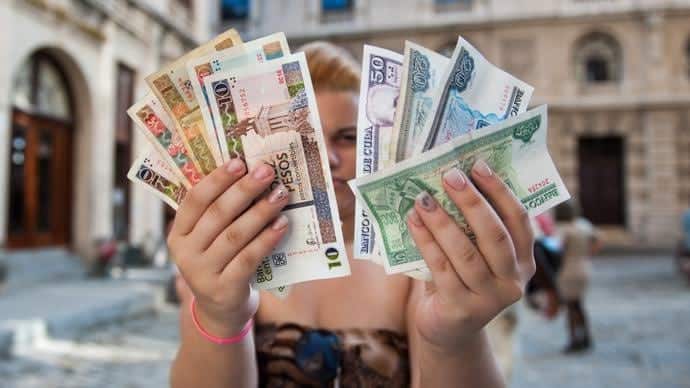
Cuban Currency: The Ultimate Guide for Travelers (2024 Update)
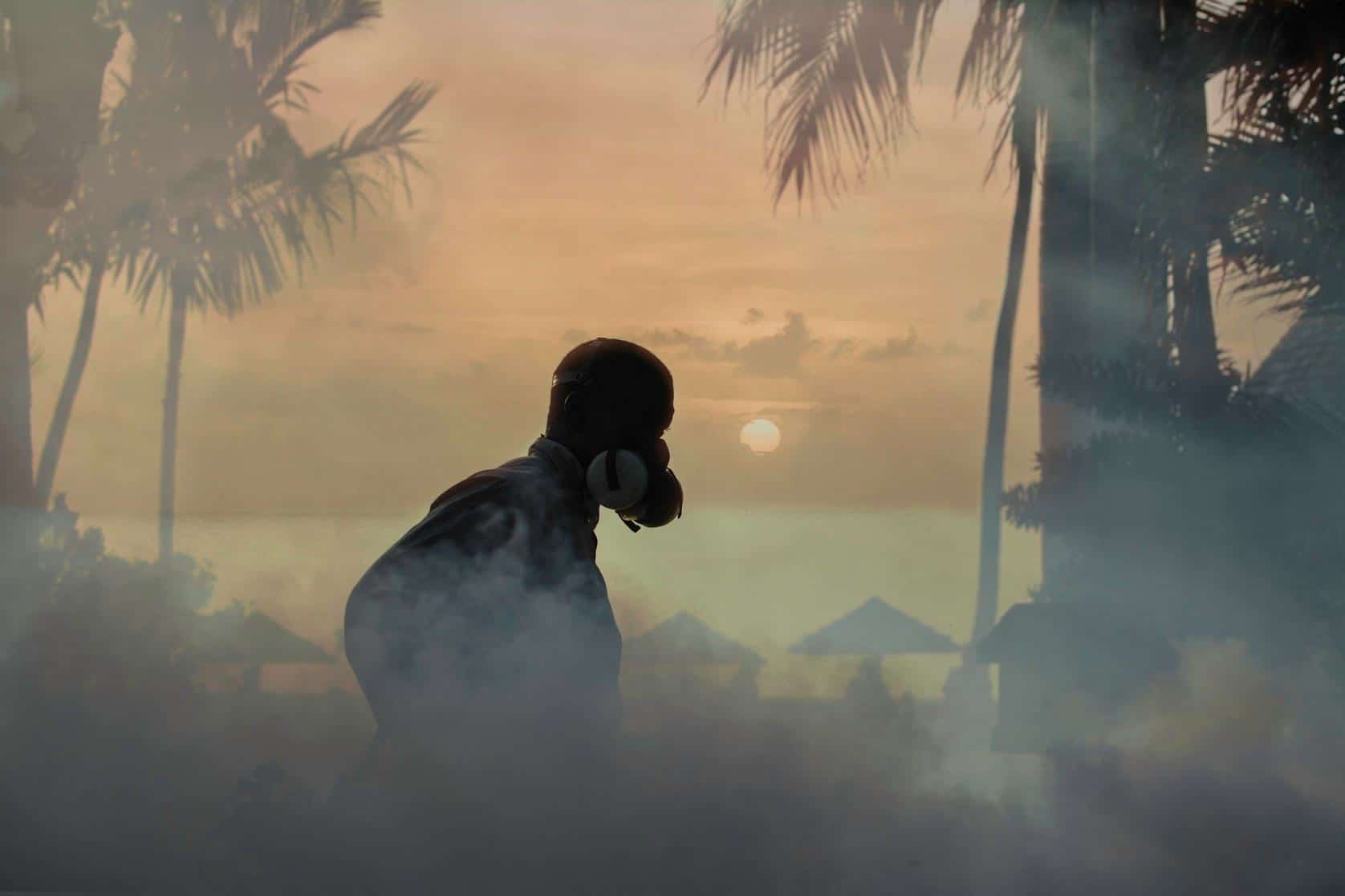
Sand Fleas and Mosquitoes in Cuba: The Survival Guide (2024)
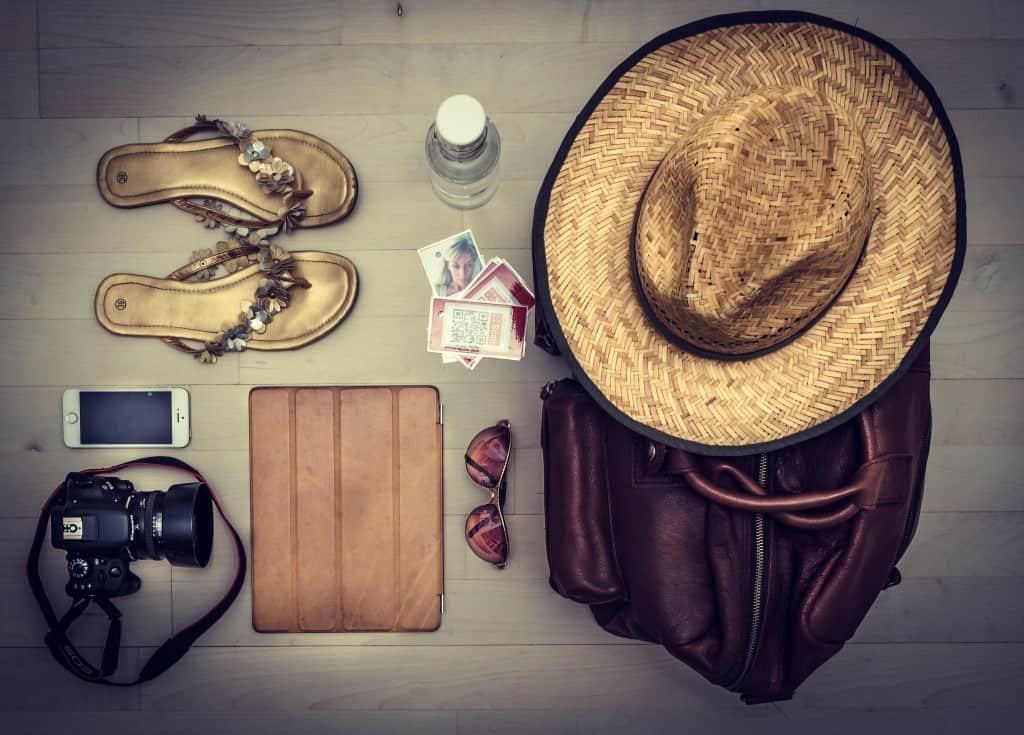
What to Bring to Cuba: The Ultimate Cuba Packing List (2024 Update)
Other stories.
Cuba weather in July
Planning a journey to Cuba this July and curious over the weather conditions to await? Your essential details are found on this page, answering your query:
What is the weather like in Cuba in July?
July in Cuba generally has very warm temperatures, with moderate precipitation.
The average maximum temperatures are very warm and range from 30°C in Cabo Cruz to 34°C in Ciego de Ávila . Nighttime temperatures generally drop to 25°C in Ciego de Ávila and 27°C in Cabo Cruz . The temperatures mentioned for both day and night are typical averages. However some days might get even hotter. It's best to stay prepared by wearing cloths suitable for the warmth.
In July, precipitation varies across different areas. From moderate rainfall in Guantanamo with an average of 33 mm to moderate rainfall in Cienfuegos with 89 mm . The city Havana usually sees around 278 hours of sunlight, indicating many sunny days.
For specific regional insights in Cuba for July, refer to the map provided below. For an in-depth overview of the yearly weather conditions, do visit our Cuba climate page .
Where to go in Cuba in July

Popular destinations in Cuba
What is the weather like in July for the 5 most popular destinations in Cuba?
Average weather in Havana
In July Havana generally has very high temperatures with maximum daytime temperatures around 32°C , minimum nighttime temperatures around 26°C and moderate monthly rainfall. So on average the conditions are pleasant that month.
Average weather in Cabo Cruz
In July Cabo Cruz generally has very high temperatures with maximum daytime temperatures around 30°C , minimum nighttime temperatures around 27°C and moderate monthly rainfall. So on average the conditions are pleasant that month.
Average weather in Cienfuegos
In July Cienfuegos generally has very high temperatures with maximum daytime temperatures around 33°C , minimum nighttime temperatures around 25°C and moderate monthly rainfall. So on average the conditions are pleasant that month.
Average weather in Guantanamo
In July Guantanamo generally has very high temperatures with maximum daytime temperatures around 32°C , minimum nighttime temperatures around 27°C and moderate monthly rainfall. So on average the conditions are pleasant that month.
Average weather in Ciego de Ávila
In July Ciego de Ávila generally has very high temperatures with maximum daytime temperatures around 34°C , minimum nighttime temperatures around 25°C and moderate monthly rainfall. So on average the conditions are tolerable that month.
Is your destination not in the list? Have a look at other destinations in Cuba .
Is July the best time to visit Cuba?
In our opinion, July is a good time to visit Cuba with overall pleasant weather in Havana .
Generally speaking, January , February , March , November and December provide perfect weather in Havana . In contrast, June , August , September and October tend to have tolerable weather conditions.
Interested in more climate information?
- January
- February
- March
- April
- May
- June
- July
- August
- September
- October
- November
- December
Weather and climate has detailed information for every country in the world. Are you going to Cuba? Get detailed historical weather averages for many cities in Cuba .
Not sure yet where to go? We now have a tool which recommends destinations that suit your ideal climate conditions. Find out where to go with our weather planner .
Can I Travel To Cuba Right Now? Here’s What To Know
Cuba travel has always been complicated. But for those of you wondering “Can I travel to Cuba right now,” we do have some good news: Cuba is open for travel and locals are excited for visitors to return to explore all that Cuba has to offer.
No one knows a place like the people who live there. Connect with a local in Cuba to start planning your trip. Learn more .
Table of Contents
- Can I Travel To Cuba Right Now?
- Does Cuba Have A Vaccination Requirement For Entry?
Do Travelers Need To Present A Negative COVID-19 Test? Is There A Quarantine Requirement?
Do travelers need anything else to enter cuba right now, what’s it like in cuba at the moment is it safe, why travel to cuba right now, work with a local to plan your trip to cuba, can i travel to cuba right now .
Yes! As always, Americans must follow certain rules to go to Cuba legally. But Cuba is open for travel , so it is possible to go there as long as you keep this in mind. Keep reading for answers to frequently asked questions about Covid and travel in Cuba.
Does Cuba Have A Vaccination Requirement For Entry?
No, Cuba does not have a vaccine requirement for entry at the moment.
Travelers do not need to present a negative COVID test or quarantine.
However, temperature screenings are performed on arrival, and travelers are randomly selected for COVID tests on arrival. If your test comes back positive you will need to quarantine at a facility designated for COVID quarantine.
Yes. Alongside the requirements for Americans , travelers will also need to fill out Cuba’s Health Declaration Form .
(If all this is feeling too complicated, then we recommend reaching out to one of our Cuba trip planners . They can walk you through what Americans need to travel to Cuba and help you out with any health or COVID considerations.)
Travel to Cuba definitely comes with some hoops to jump through these days. But it can be a rewarding pandemic destination — as long as you know what to expect.
Generally, Cuba is safe for travel with a little know-how. Obviously, the pandemic has changed the calculus a little when it comes to safety.
At the beginning of the pandemic, COVID-19 cases in Cuba were fairly low. In fact, they were so low that Cuba actually sent doctors abroad to help out other countries. Since then, cases have risen and fallen in waves as we've seen globally.
Masks are still required in healthcare settings and on public transportation. They're recommended elsewhere, but not required.
So is Cuba safe? Like anywhere, travel to Cuba comes with elevated risks because of the coronavirus pandemic. But if you’re vaccinated, know what to expect, and understand how to travel there, then you can have a rewarding trip in Cuba.
We’ve always believed that travel — done right — can be a force for good. Destinations like Cuba have historically relied heavily on tourism to support their economy. So going to Cuba now can be a boost for Cubans across the island.
It can also be an especially rewarding experience for travelers. For starters, tourism is currently low across the island. That means that travelers can get a rare look at Cuba without the crowds.
Plus, Cuba is full of activities that can be done outdoors — and it’s generally agreed that fresh air lowers the risk of the coronavirus. If you’re worried about COVID-19, you’ll have the option to spend the day on the beach, on the water, or on the veranda of a cafe.
All that makes Cuba a good pandemic destination although, of course, traveling during the pandemic does come with risks.
At ViaHero, we’ve always believed that local knowledge can enrich a travel experience. After all, who knows a place better than the people who actually live there?
Today, that’s more true than ever. Pandemic conditions can change — quickly. And it can be tough to keep up with the ever-shifting rules around masking, social distancing, capacity guidelines, and vaccine requirements.
It isn't just about staying safe, either. In the #beforetimes, we could all find tons of "top ten" lists online that offered a rough guide of what to do in a destination. Today, those are simply out of date. Not only do they list restaurants and bars that have closed, but they don't offer information that today's travelers need — like which places have good outdoor seating.
Knowing a local in your destination means that you have access to all the latest news and tips about traveling there. Our locals in Cuba, for example, can let you know which bars have closed during the pandemic, which restaurants offer good (uncrowded) outdoor seating, and which beaches the locals are loving the most right now.
And, of course, they can offer safety tips and best practices to help keep your trip safe. Basically, they can design a trip that fits both your travel style and your risk tolerance.
Ready to have a local plan for your trip to Cuba? Connect with a local today to learn more.
Where else is open for travel? Check out our articles on if Americans can travel to Mexico (and when ). Next, see if Americans can go to Puerto Rico , and what the rules are for Americans going to Portugal .
Looking for more info?
- Cuba Travel Guide
- When to Visit Cuba
Best Time to Visit Cuba
- Jan Avg Daily: 26 ° C Avg Nightly: 16 ° C
- Feb Avg Daily: 27 ° C Avg Nightly: 17 ° C
- Mar Avg Daily: 28 ° C Avg Nightly: 18 ° C
- Apr Avg Daily: 30 ° C Avg Nightly: 19 ° C
- May Avg Daily: 31 ° C Avg Nightly: 21 ° C
- Jun Avg Daily: 32 ° C Avg Nightly: 22 ° C
- Jul Avg Daily: 32 ° C Avg Nightly: 22 ° C
- Aug Avg Daily: 32 ° C Avg Nightly: 22 ° C
- Sep Avg Daily: 31 ° C Avg Nightly: 22 ° C
- Oct Avg Daily: 30 ° C Avg Nightly: 20 ° C
- Nov Avg Daily: 28 ° C Avg Nightly: 19 ° C
- Dec Avg Daily: 27 ° C Avg Nightly: 18 ° C
- 1.11K views
- ~ mins read
Although Cuba is a year-round tropical destination, the best time to visit the country is during the dry season, between November and April. During these six months, Cuba boasts the best weather conditions, perfect for sunbathing on its pristine beaches or heading out on a sightseeing tour of its wonderful Spanish architecture. You can also plan your trip to Cuba from December to March or July to August if you wish to indulge in the high-season attractions and activities.
So at the end of the day, the ideal time to visit Cuba depends on individual travel preferences. Listed below is all the information you need on the country’s seasons and ideal time for enjoying certain activities and highlights of the country.
Quick Facts
Seasonal overview.
Cuba does not experience four distinct seasons like most regions. Instead, it has two seasons: the dry season (November to April)and the wet season (May to October). As both seasons see summer-like temperatures, the country does not have a winter per se.
Dry season in Cuba — November to April

The dry season in Cuba starts in November, with temperatures coming to a more agreeable range and the chances of rainfall taking a huge dip. The following months show the same weather trend but have their unique draws. Tourist season starts in December and continues until March. Sightseeing tours of famous cities such as Havana , Trinidad , and Varadero are particularly famous during this period. December offers exceptional birdwatching conditions, while February is the best time for enjoying watersports along Cuba's stunning coastlines, including the Varadero Beach . In April, higher temperatures start creeping in, and you can enjoy all of the dry season activities in a less-crowded setting. Cuba also hosts several of its cultural festivals during the dry season. So if you want to enjoy tons of holiday activities, cultural events, and beautiful weather conditions, the dry season is hands down the best time of the year to visit Cuba.
Highlights:
- Embark on a horseback riding tour or hike through the verdant tobacco valleys of Viñales, taking advantage of clear skies and less humid conditions.
- Head to the South Coast beaches, such as Playa Ancon, in February for prime snorkeling and diving conditions.
- Celebrate Christmas and New Year’s in a tropical style, with lots of sunshine and seafood. Head to the town of Remedios in Cuba for Las Parrandas de Remedios Christmas Festival , which takes place for an entire week around Christmas. Also, don’t miss out on the New Year’s Eve celebrations, which is also the anniversary of the Cuban Revolution and is celebrated with gusto.
- Witness over 260 species of migratory birds in Cuban wetlands, such as the Zapata Swamp. Visitors can also head to the highest point at the Gran Parque Nacional Sierra Maestra and enjoy the sweeping views of mountains and forests.
Travel tips:
- Book your accommodations in advance since the dry season is when prices for hotel rooms go up, soaring even higher during Christmas and New Year weeks.
- Since the Wi-Fi service in Cuba is limited, bringing a guidebook or purchasing an international roaming data pack is advisable to navigate your way around if you are on a solo Cuba trip.
- Because the weather is sunny throughout the dry season, you’ll only have to pack lightweight cotton clothes for your trip.
- Most hiking trails in Cuba can be walked on with trainers, but some require light walking boots, so be sure to pack both just in case.
In-depth month-wise guides: Cuba in November Cuba in December Cuba in January Cuba in February Cuba in March Cuba in April
Wet Season in Cuba — May to October

The wet season in Cuba starts in May and continues through October, bringing hot and humid weather along with short but heavy rainfall. May sees the highest jump in average rainfall compared to the month preceding it, while October is the rainiest month. Though the hurricane season lasts throughout Cuba’s wet period, the actual risk is between August and October. Being predominantly the low season, there is a dip in the accommodation and travel prices during this period. Prices pick up in July and August, given it is the summer holiday period in most of America. As local schools are also shut from July to August, expect a lot of crowds on major beaches like Cayo Blanco and in places like Punta del Este.
- Swim in the pristine waters of the Caribbean Sea, which boasts the best average sea temperature of 30°C (86°F) in August.
- Join locals to celebrate world-renowned festivals such as the Carnival in Santiago de Cuba .
- Embark on a leisurely museum tour in Havana or a sightseeing tour in Trinidad , where you can learn about Cuba’s colonial architecture and history during the low tourist season.
- Enjoy the best prices in accommodations and airfare throughout the season, especially during the starting months of the wet season (May and June), which sees the highest jumps in rainfall and temperature, drawing fewer tourist crowds.
- Time your visit between May and July to witness baby sea turtle hatchlings entering the sea, especially along the Península de Guanahacabibes.
In-depth month-wise guides: Cuba in May Cuba in June Cuba in July Cuba in August Cuba in September Cuba in October Cuba is a tropical paradise that you can visit any time of the year. So, the best time to travel to this country depends on your travel preferences, be it weather, specific preferences of festivals and activities, or vacation schedule.
Want to research more on the country to plan your visit? Read our Cuba travel guide for all the information you need. Or fill out our Cuba customized trip form and let our local travel experts create an itinerary based on your interests.
Related Articles
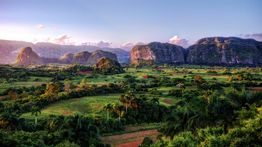
Cuba in January: Excursions and Unpredictable Weather
January is the peak tourist season in Cuba. V... read more

Cuba in February: Weather, Destinations and More
From its vintage cars, paradisiac beaches, an... read more
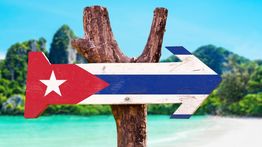
Cuba in March: Weather, Festivals and Wildlife
Cuba should be on every traveler’s bucket lis... read more
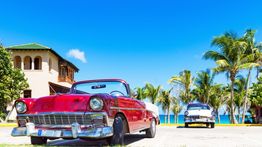
Cuba in April: All You Need to Know
April is generally considered one of the best... read more
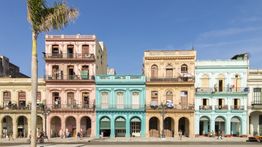
Cuba in May: Travel Tips and Weather Advice
Thinking about touring Cuba in May? From cult... read more

Cuba in June: Weather, Travel Tips & More
Exploring Cuba is more relaxed compared to th... read more
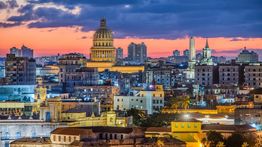
Cuba in July: Best Destinations, Tips and Weather
Travel to Cuba and head out to beach resorts ... read more
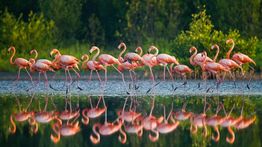
Cuba in August: Rainy Season Travel Tips
August evokes the perfect summer mood in Cuba... read more
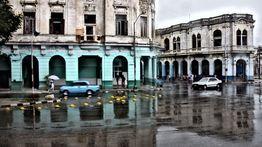
Cuba in September: Exploring in Monsoon Weather
From touring the attractions of Havana, Barac... read more
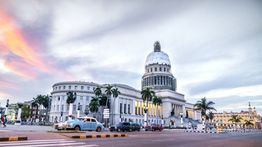
Cuba in October: Peak Monsoon Travel Tips
October lies smack in the middle of the Cuban... read more
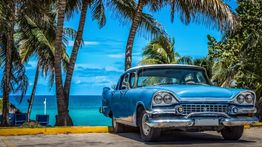
Cuba in November: Travel Tips and Weather
With the wet season in Cuba nearly over, Nove... read more
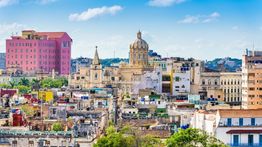
Cuba in December: Fine Weather and Travel Opportunities
Though Cuba is located in close proximity to ... read more
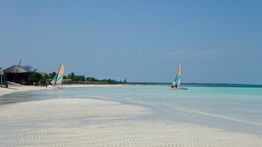
Summer In Cuba: Weather And Top Destinations
Cuba is a tropical paradise that entices visi... read more
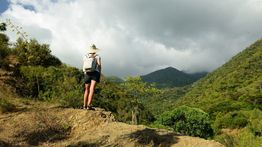
Winter in Cuba: Weather and Destinations to Visit
Say goodbye to the harsh cold weather at home... read more

Popular Destinations
- Europe Tours
- Everest Base Camp Trek
- Italy Tours
- Spain Tours
- Argentina Tours
- Canada Tours
- Sri Lanka Tours
- Chile Tours
- Antarctica Tours


IMAGES
VIDEO
COMMENTS
Weather. With annual maximum temperatures reaching 90°F (32°C) in Havana and Western Cuba, and somewhat more in Santiago de Cuba and Oriente, this is one of the hottest and most humid months of the year. Mid-summer is also the heart of rainy season, but July is considerably less rainy than June or September. Most rain falls as heavy afternoon ...
If you happen to visit Cuba in July there are a few special celebrations that you will want to be a part of. July 26th is Revolution Day in Cuba. On this day in 1953 Fidel and Raul Castro led an attack on the Moncada military base, which essentially kicked the Cuban Revolution into gear. Regardless of what you might think about Cuban politics ...
Temperatures in Cuba in July. You'll usually find temperatures from 23 to 31 Celsius (73 - 88 Fahrenheit) and while there may be some rain it tends to be brief, although it is likely to be moderately humid. Overnight lows will be around 23-25 Celsius (73 - 77 Fahrenheit), which can be very warm for some.
Unlike the previous month, cloud coverage in July decreases as the month progresses, and you will likely see more sunshine during the day as August approaches. Sunshine Hours. There are nine hours of sunshine every day on average in Cuba in July, with the sun tending to rise just before 7 am and setting around 8.15 pm every evening.
July and August are the hottest times to visit Cuba. The summer months of July and August are the liveliest time of the year to visit Cuba but also the hottest, and there's a fair amount of rain. Local schools are closed and it's the height of the domestic tourism season, so expect jam-packed beaches and busy hotels in popular tourist ...
To enter Cuba, all visitors need to present a completed Tourist Card — which serves a similar function to a tourist visa. These are usually available through your airline (ask when booking). Alternatively, you can purchase one through a Cuban travel agency. Costs range from US$50 to US$85, including processing fees.
1. Double-check your insurance. You are required to have medical insurance to visit Cuba and will need to bring digital or printed proof of your policy. Random checks are made at the airport. If you arrive without insurance, you'll be asked to buy a Cuban policy at the airport for US$30. 2.
You can visit Cuban cigar factories and tobacco farms, attend seminars, or book special cigar dinners that blend signature aromas with the right food pairings. March: The largest Carnival on the island is held at Santiago de Cuba. Parades can easily last until 3 AM, but the party usually continues until sunrise.
When afternoon rains clear, you can join the families strolling along the Malecón sea wall on the edge of Havana Bay. Sportfishing: July is the peak month for game fishing in Cuba. Famous authors such as Zane Grey and Ernest Hemmingway would travel to Cuba from the US every July to indulge their game-fishing passion, and you can do the same.
The best time to visit Cuba depends on where you're going and what you're hoping to see. Discover the best time of year for travelling to Cuba and start planning your trip with our complete guide. ... May and June temperatures make for comfortable travel. July through September sees temperatures soar to around 32˚C in Havana and Pinar del Río ...
Come to Cuba in dry, sunny winter and spring for fantastic outdoor activities, including some memorable hiking and idyllic beaches. And tap into the island's cultural activities in the wetter summer and fall months, especially the diverse music scene and museums in big cities like Havana, Matanzas, Camagüey, and Santiago de Cuba. Below, learn the reasons for visiting this spellbinding island ...
With temperatures hovering between 20-35°C and the water bathtub-warm year-round, Cuba has a classically cosy Caribbean climate. November to April is the best time to visit Cuba, with March to mid-April the most pleasant months: warm and sunny without summer's humidity or storms. Prices may be slightly lower in January-February, when night ...
As well as being stormy, July can be hot across most of Cuba - particularly in the built-up cities of Santiago de Cuba and Havana. Adventurous families won't be put off, though, and the prices and number of tourists rise during the school holiday period of July to August. Be sure to book in advance if travelling to Cuba in July.
What Americans need to know about traveling to Cuba. Making sense of the new travel policies and rules. This year, Cuba ranked as the top trending destination in the 2023 Travelers' Choice awards, meaning Cuba-focused pages on Tripadvisor are seeing an increase in year-over-year activity. But having swung back and forth throughout the last ...
American Travel to Cuba. The short answer to the question "can Americans travel to Cuba" is YES, American citizens can travel to Cuba. Non-U.S. citizens are allowed to travel to Cuba via the United States as well. American citizens can fly from the United States directly to Cuba, travel independently (no need for a group trip or guided trip ...
Cuba travel expert Brendan Sainsbury describes his first time back to the island since the pandemic began. Here's what you need to know about visiting Cuba. ... In early July, Cuba tentatively announced it was ready to reopen several of its offshore islands to tourism. Even better, to lure back nervous travelers and help boost the country's ...
Best time to go. Cuba is a great destination year round, but is insufferably hot in July and August (though the city of Santiago de Cuba hosts two riotous, musical festivals in July that are worth ...
July is an ideal month to get to know Cuba in summer and cool off on its spectacular beaches. You should wear light clothing that allows you to walk comfortably and coolly when going on excursions, and a pilot or light coat that can protect you in case a rain surprises you. It is also recommended that you bring garments to protect from the sun ...
The simple answer is yes. It's perfectly legal for Americans to travel to Cuba, except for explicit tourism purposes. Americans can't go to Cuba for tourism thanks to the Cuban Assets Control Regulations of July 8, 1963, which imposed a trade embargo on the island.. However, you can travel legally to Cuba if you comply with certain Cuban and US government regulations.
July in Cuba generally has very warm temperatures, with moderate precipitation. The average maximum temperatures are very warm and range from 30°C in Cabo Cruz to 34°C in Ciego de Ávila. Nighttime temperatures generally drop to 25°C in Ciego de Ávila and 27°C in Cabo Cruz . The temperatures mentioned for both day and night are typical ...
Yes! As always, Americans must follow certain rules to go to Cuba legally. But Cuba is open for travel, so it is possible to go there as long as you keep this in mind. Keep reading for answers to frequently asked questions about Covid and travel in Cuba.
Most hiking trails in Cuba can be walked on with trainers, but some require light walking boots, so be sure to pack both just in case. In-depth month-wise guides: Cuba in May Cuba in June Cuba in July Cuba in August Cuba in September Cuba in October Cuba is a tropical paradise that you can visit any time of the year.
And in spite of the weather, there are some major advantages to off-season travel. You won't be competing with crowds, and early summer travel offers the lowest prices of the year. ... Cuba in May Cuba in July Best TIme to Visit Cuba Cuba FAQ. Written by Christopher P Baker, updated Feb 18, 2021. Our local travel specialists have been ...